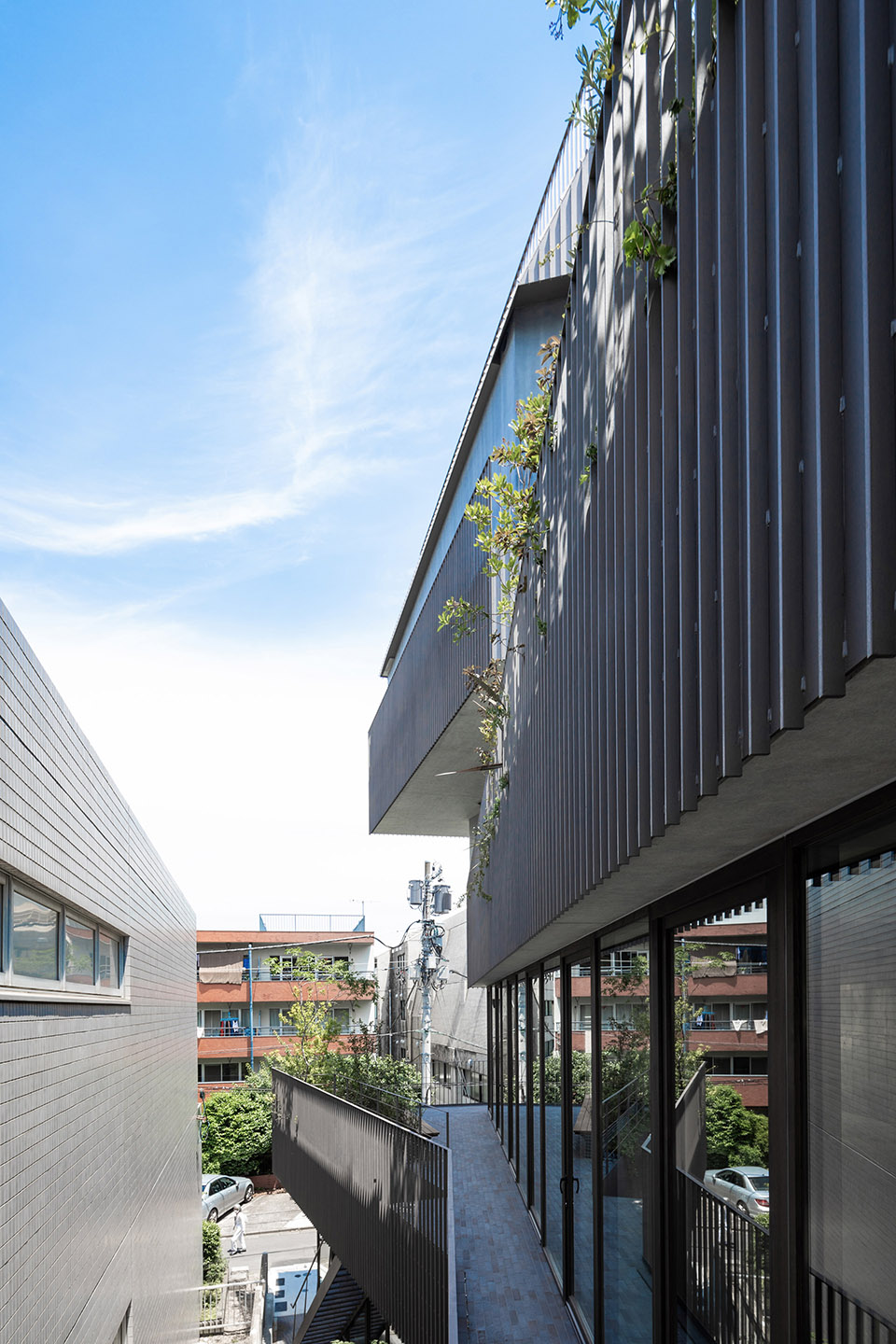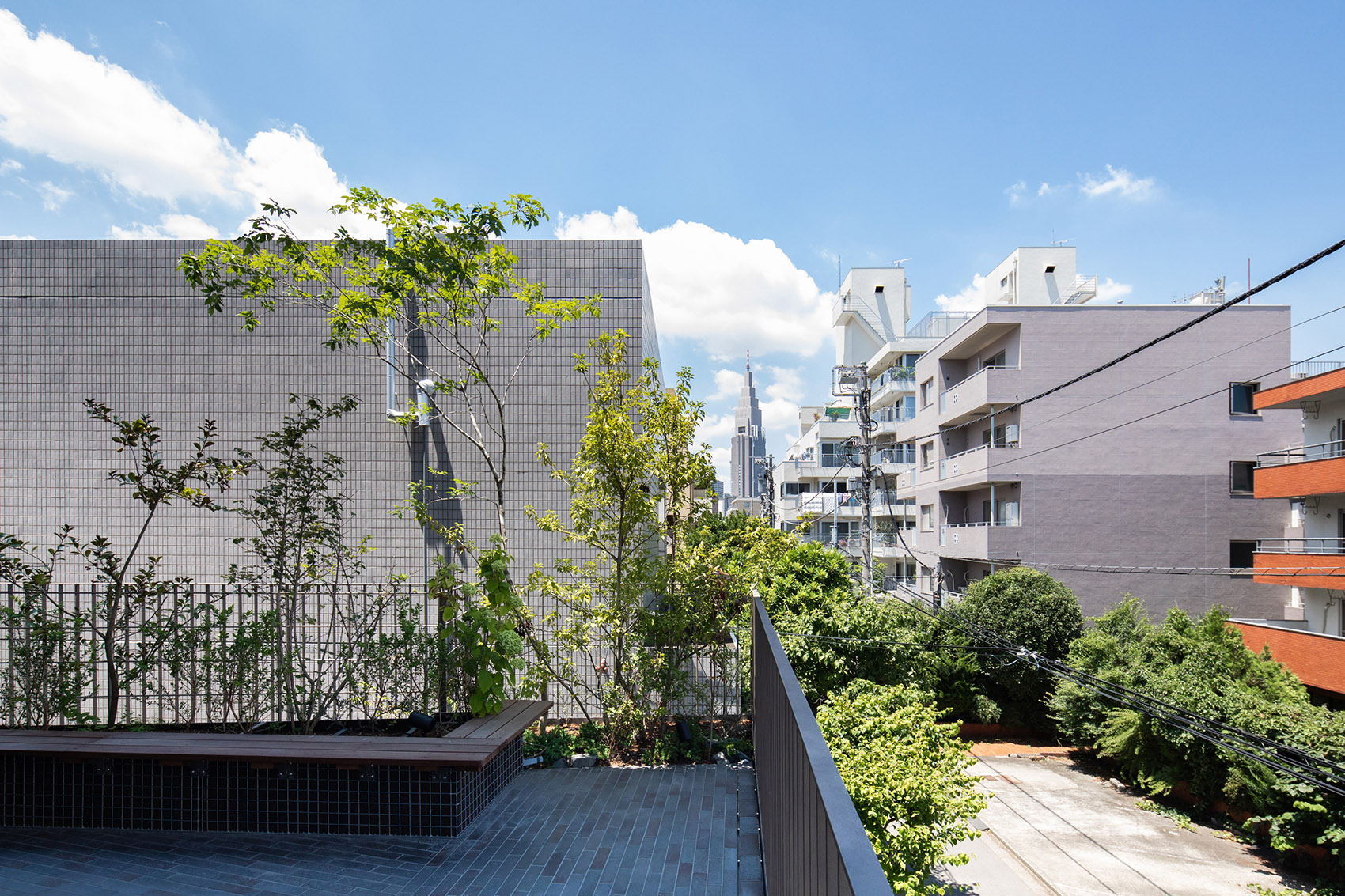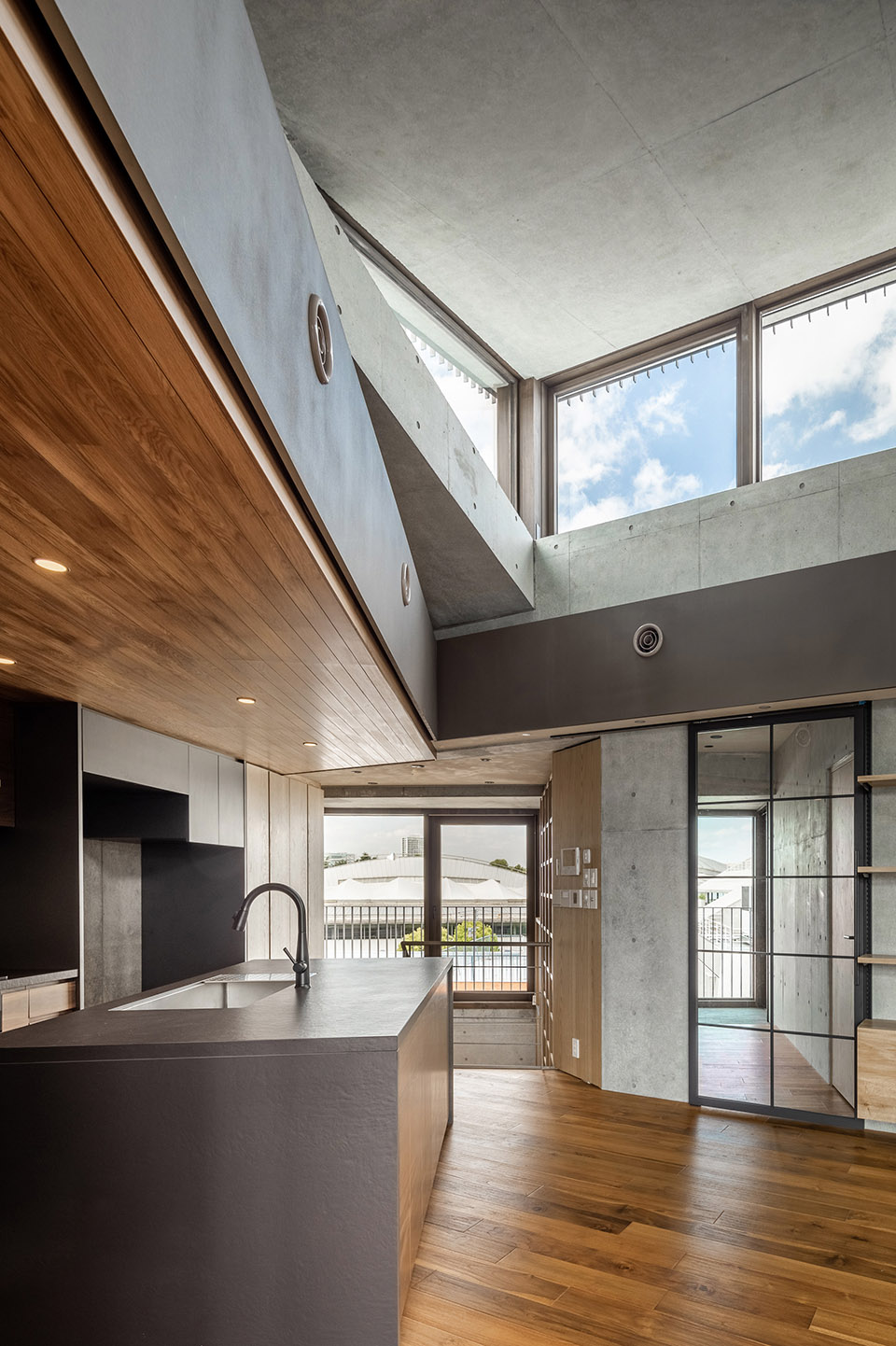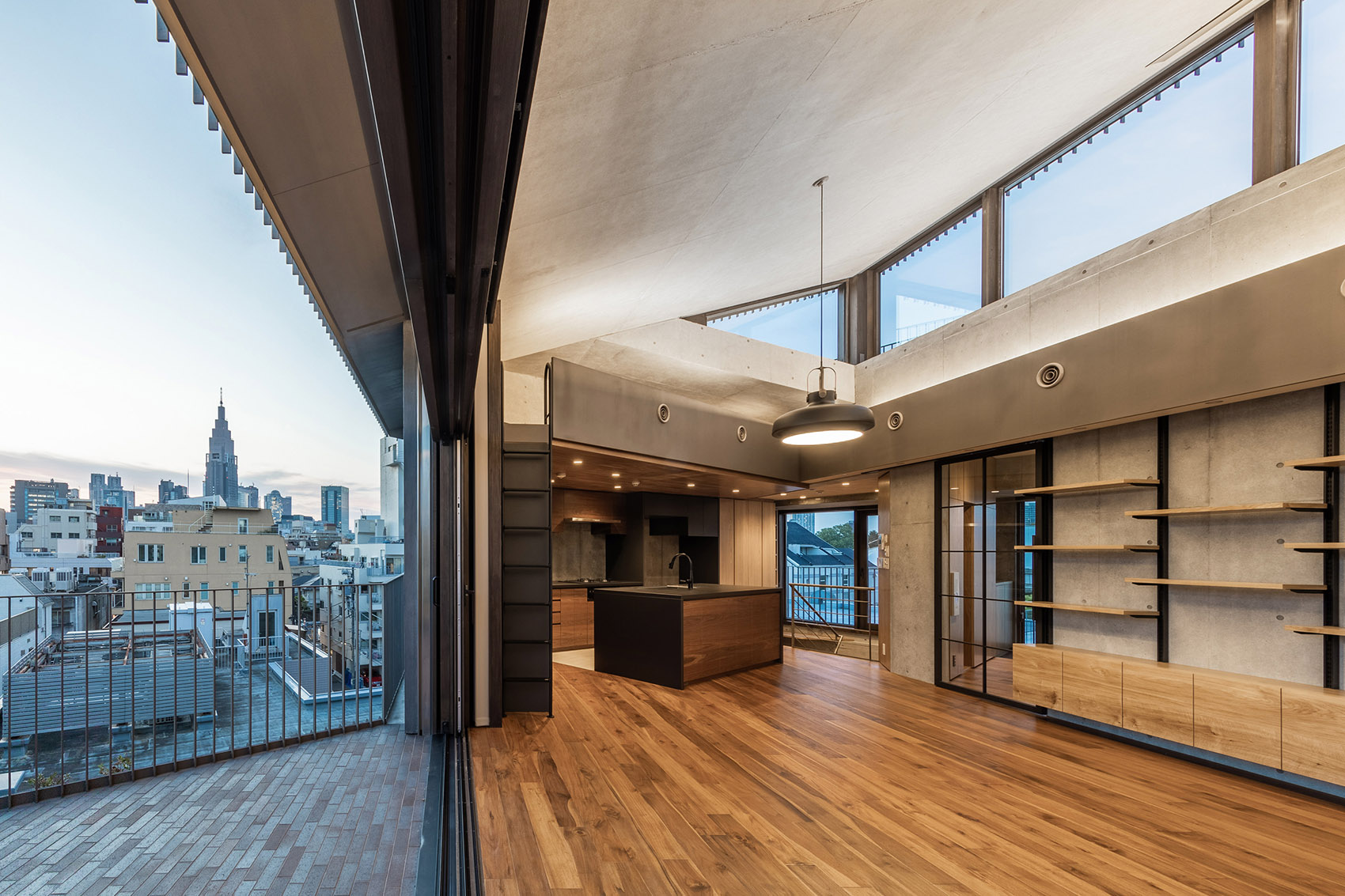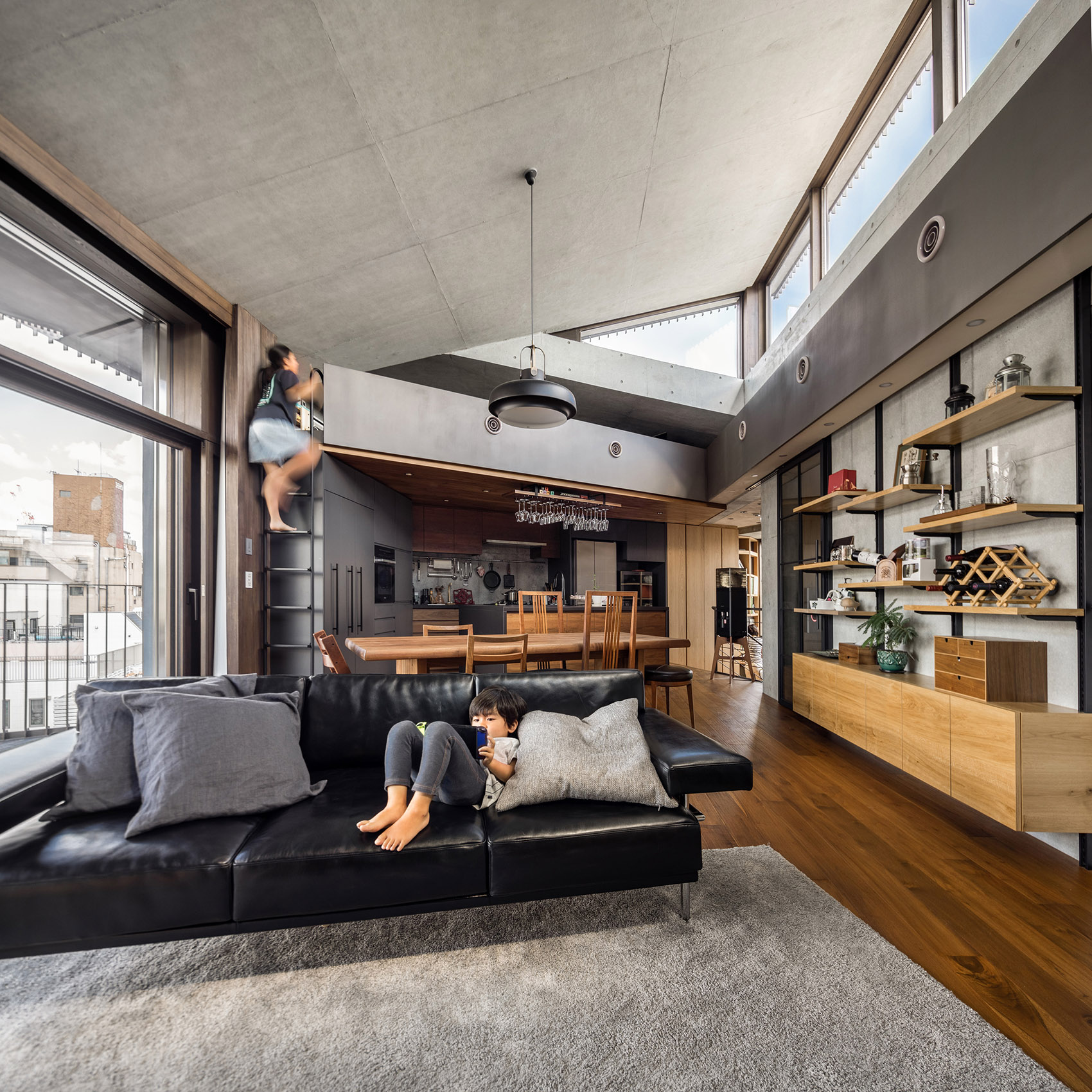该项目位于东京国家体育场附近的千駄谷商业和住宅混合区域,由两层租户空间和业主的私人住宅组成。由于前街狭窄,因此场地上允许的最大容积率仅为1.6,该项目的主要挑战是如何在容纳舒适的居住环境并留出足够盈利的租户空间的同时,在场地限制下最大化空间体积。业主是一个五口之家,他们曾经住在一处宽敞的带花园的独栋住宅中,在搬到这里之前,他们曾担心新家的空间质量会因为周边密集的人口环境以及生活空间面积的减少而降低。因此,设计核心理念旨在通过积极整合室外空间,将住宅尽可能地向外部开放,从而营造出宽敞舒适的居住环境,巧妙转化场地限制的不利因素。
▼远景鸟瞰,bird’s eye view at distance © Vincent Hecht
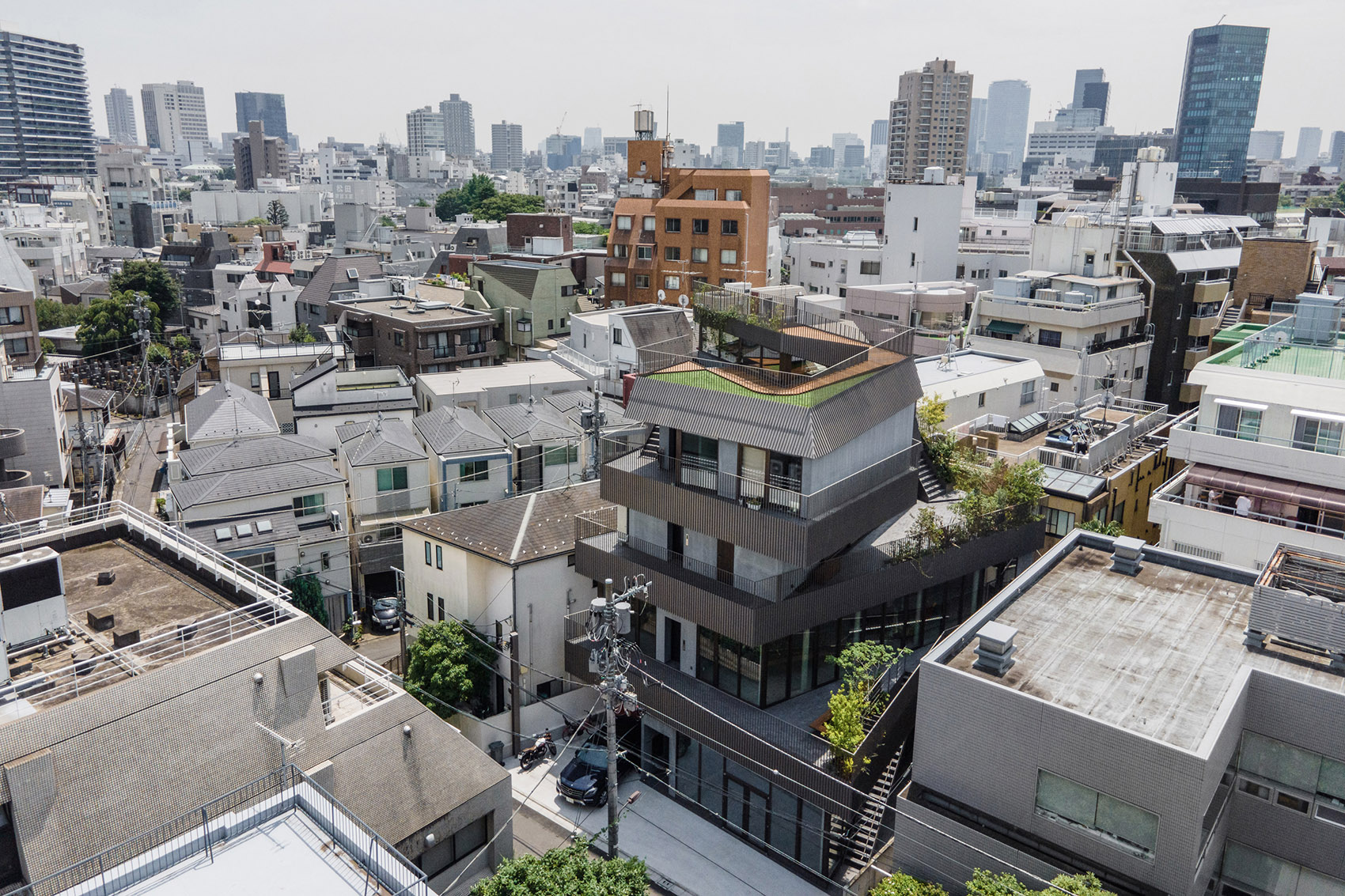
▼近景鸟瞰,closer view of the duplex © Vincent Hecht

Located in a mixed area with commercial and residential uses in Sendagaya near the National Stadium in Tokyo, this project is composed of two stories of tenant spaces and the client’s residence above them. With only 160% of the maximum floor area ratio due to the narrow front street, the main challenge of the project is how to accommodate both comfortable residential environments and sufficiently profitable tenant spaces together, while maximizing spatial volume within the site constraints. The client, a family of five who used to live in an ample detached house with a garden had concerns about the spatial quality of their new house with less area in the denser neighbourhood. Thus, we tried to make it as open and generous as possible by actively incorporating outdoor spaces, despite the difficult site constraints.
▼航拍顶视图,aerial top view © Vincent Hecht
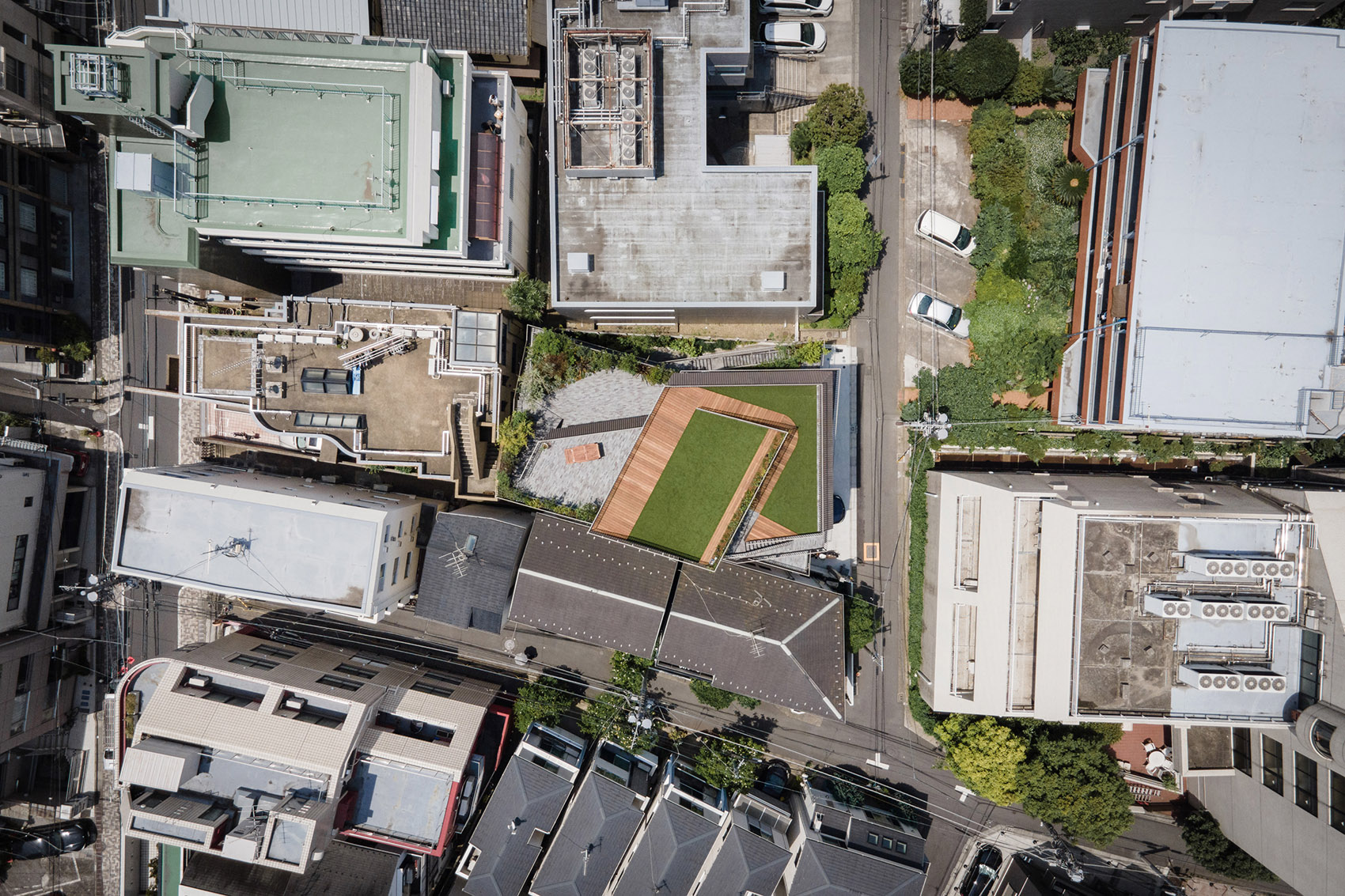
▼露台顶视图,aerial top view of the terraces © Vincent Hecht
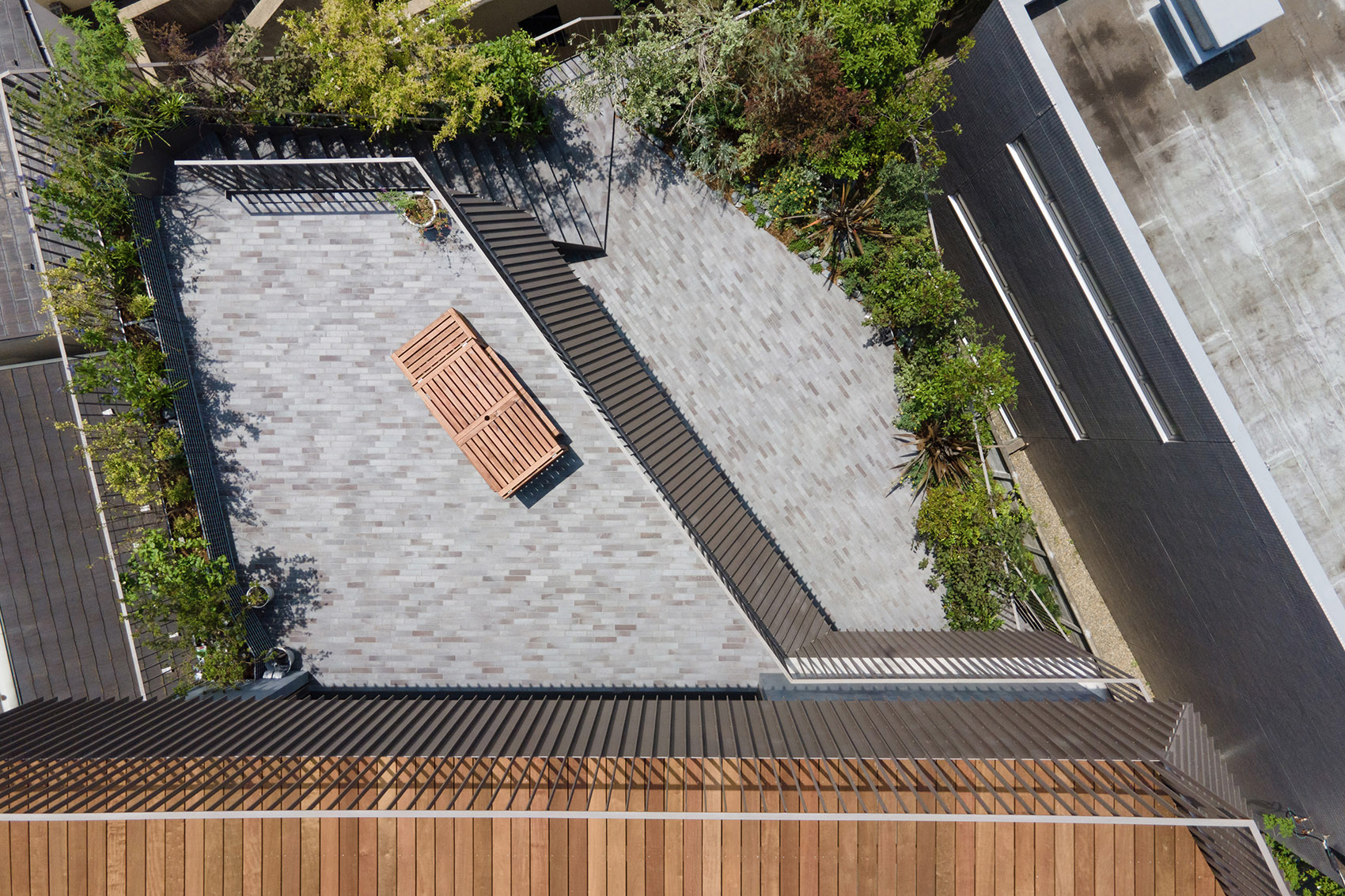
尽管场地允许建造的容积率较低,但是,在经过复杂而精确的阴影计算后,且不影响其他建筑采光的前提下,场地上可建造的最大高度却可以达到20米。虽然如此,为了避免邻里之间不必要的法律纠纷,附近的大多数建筑均保持在10米以下。对于住宅用地来说,这条社区街道水平方向上的建筑密度确实相对较高,但是建筑师却在其间发现了潜在的开放空间,即周围的低矮建筑之上的空间,这种策略为创造舒适的环境打下了基础。为了达到这一目标,设计团队对建筑北侧相对较高的部分进行了深入的体量研究,利用阴影参数将复式住宅提升到比邻近屋顶更高的位置,同时最大化建筑体量,这种设计为住宅创造出开放的景观视野,同时形成了层次丰富的屋顶露台。
Despite the low floor area ratio allowance, the maximum building height at this site is indeed allowed to be 20m only if the volume is adapted to the complicated shadow calculation, although most of the buildings nearby are kept lower than 10m to avoid extra code compliance processes. While this neighbourhood is relatively dense on the street level for residential use, we found potential open voids to create comfortable environments above the surrounding low buildings. Therefore, the building massing taller on the northern side is a result of our thorough volume studies with shadow parameters to elevate the duplex residence higher than neighbouring roofs while maximizing the building volume, which provides open views all around the residence with multiple levels of abundant roof terraces.
▼由街道看向建筑,viewing the building from the street © Vincent Hecht
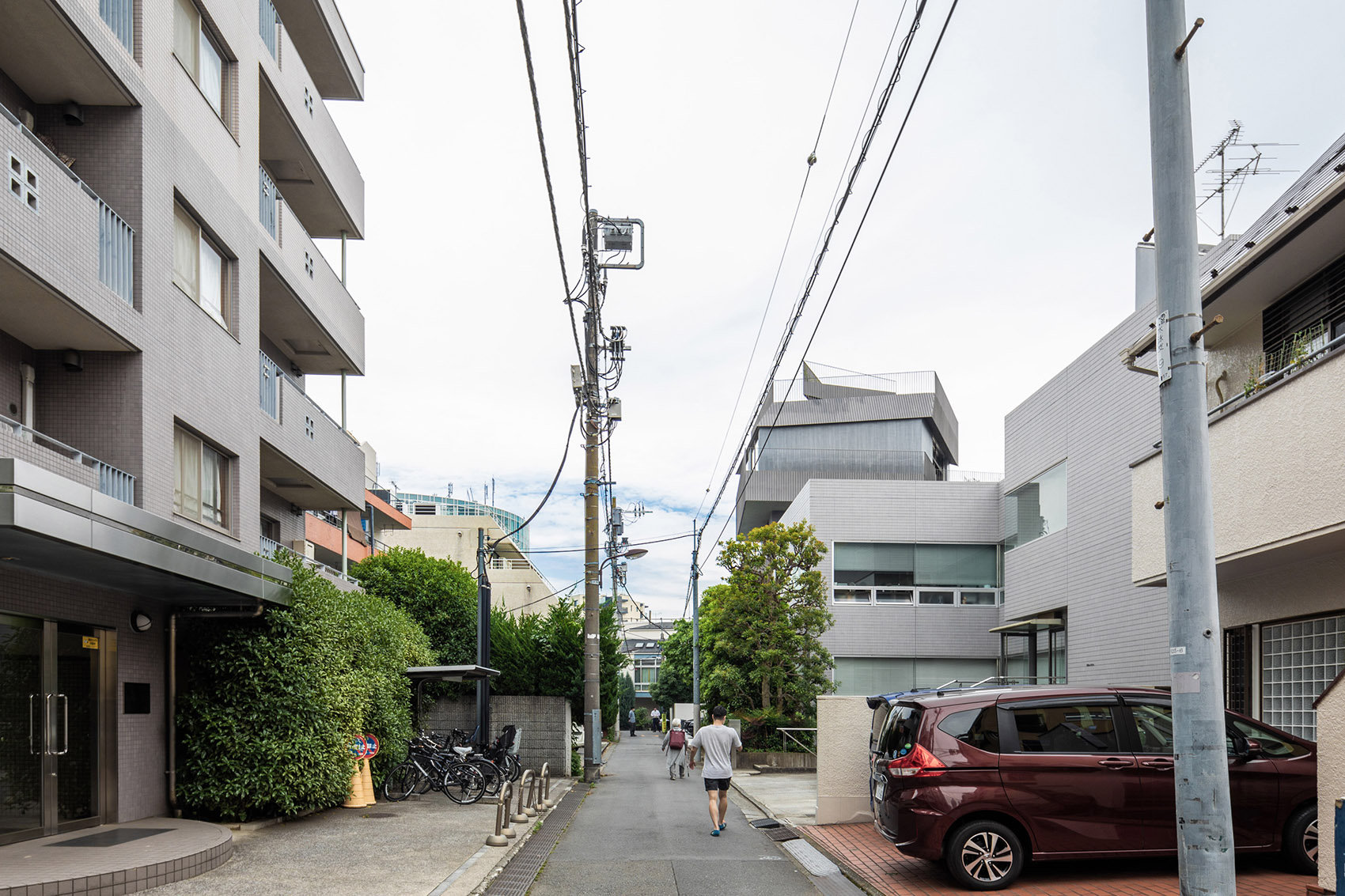
▼沿街立面概览,facade along the street © Vincent Hecht
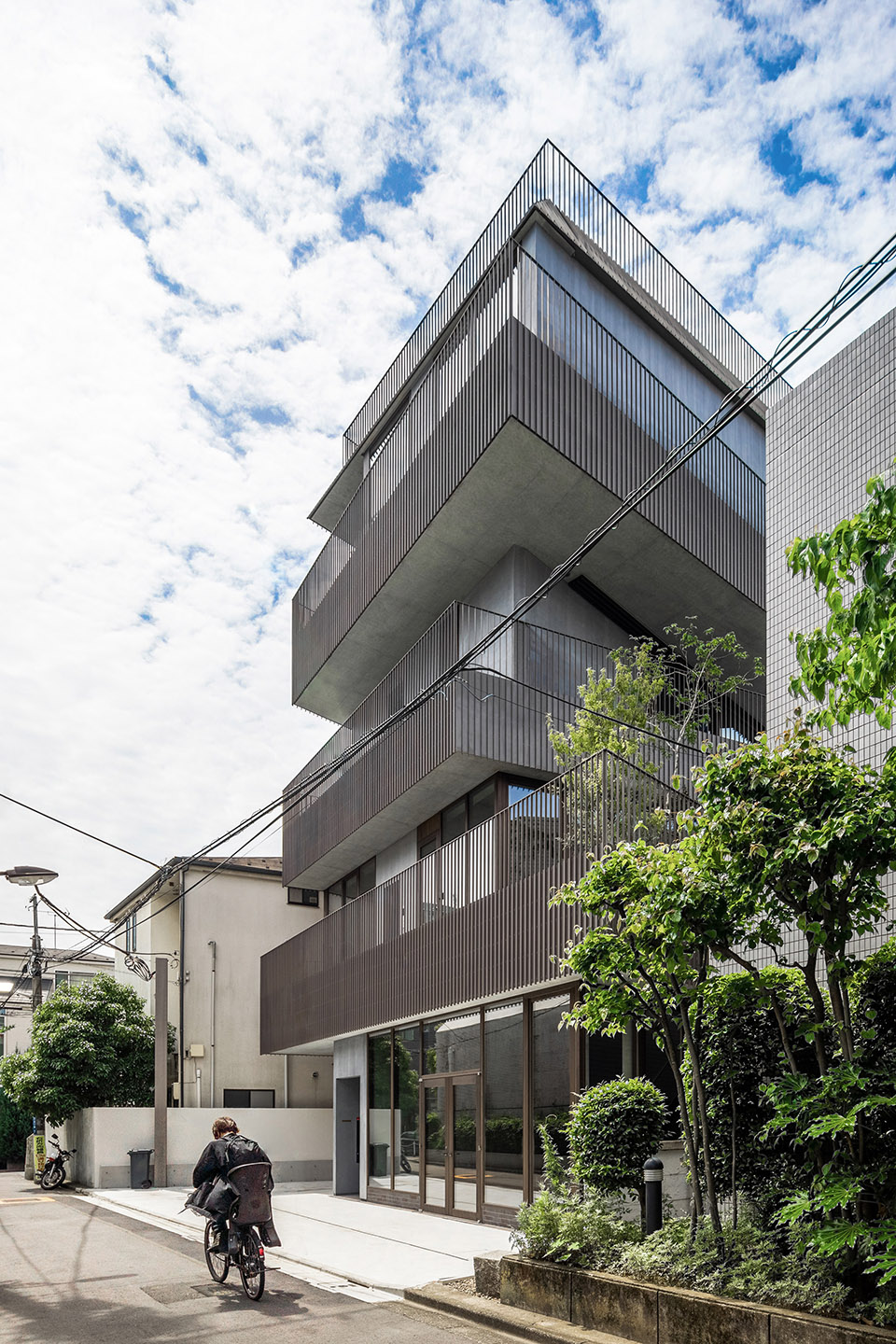
根据阴影计算、空间用途、空间序列以及竖向关系,楼板的形状在每一层都采取了独特的斜切处理。不同楼层的堆叠形成了悬挑出来的遮阳结构与各种各样的户外空间,如外部走廊和露台,这些户外空间是不受建筑面积的限制。封闭立面的主承重墙沿场地边界排布,而露台立面则采用了铰接的深混凝土梁,这种结构使这一侧的立面更加透明开放,将内外空间进一步地融合在一起。
The floorplate shapes are uniquely skewed at each level according to the shadow regulation, usages, spatial sequences, and vertical relationships. This stack of different floorplates generates shading overhangs and various outdoor spaces such as external hallways and terraces without interrupting GFA limitations. Besides the closed building facade along the site boundary accommodating main loadbearing walls, the articulated deep concrete beams allow the façade structure along the terraces to be open and transparent encouraging inside and outside to merge.
▼不同楼层的堆叠形成了悬挑出来的遮阳结构与各种各样的户外空间 © Vincent Hecht the stack of different floorplates generates shading overhangs and various outdoor spaces

围合楼板的立面上设置了竖向百叶状的金属格栅,超过立面的部分形成了露台的扶手栏杆。这种设置不仅满足遮阳要求,同时连续的垂直百叶允许同一方向上的视线穿过,而阻挡了斜角上的视线,在开放性与隐私性之间创造出微妙的平衡。此外,伸延出来的金属格栅还强调出建筑的水平体量,增强了体量堆叠的视觉效果。
The linear facades around the slab volumes are wrapped by the metal bands with repetitive vertical slats like louvers, which are designed from the positive interpretation of the code requirements forcing vertical slats design to rooftop balustrade to conform to the shadow regulation. The continuous vertical louvers allow for interplay between openness to the perpendicular views and privacy from the diagonal views besides enhancement of horizontality of the floor layers.
▼主入口立面,main entrance facade © Vincent Hecht
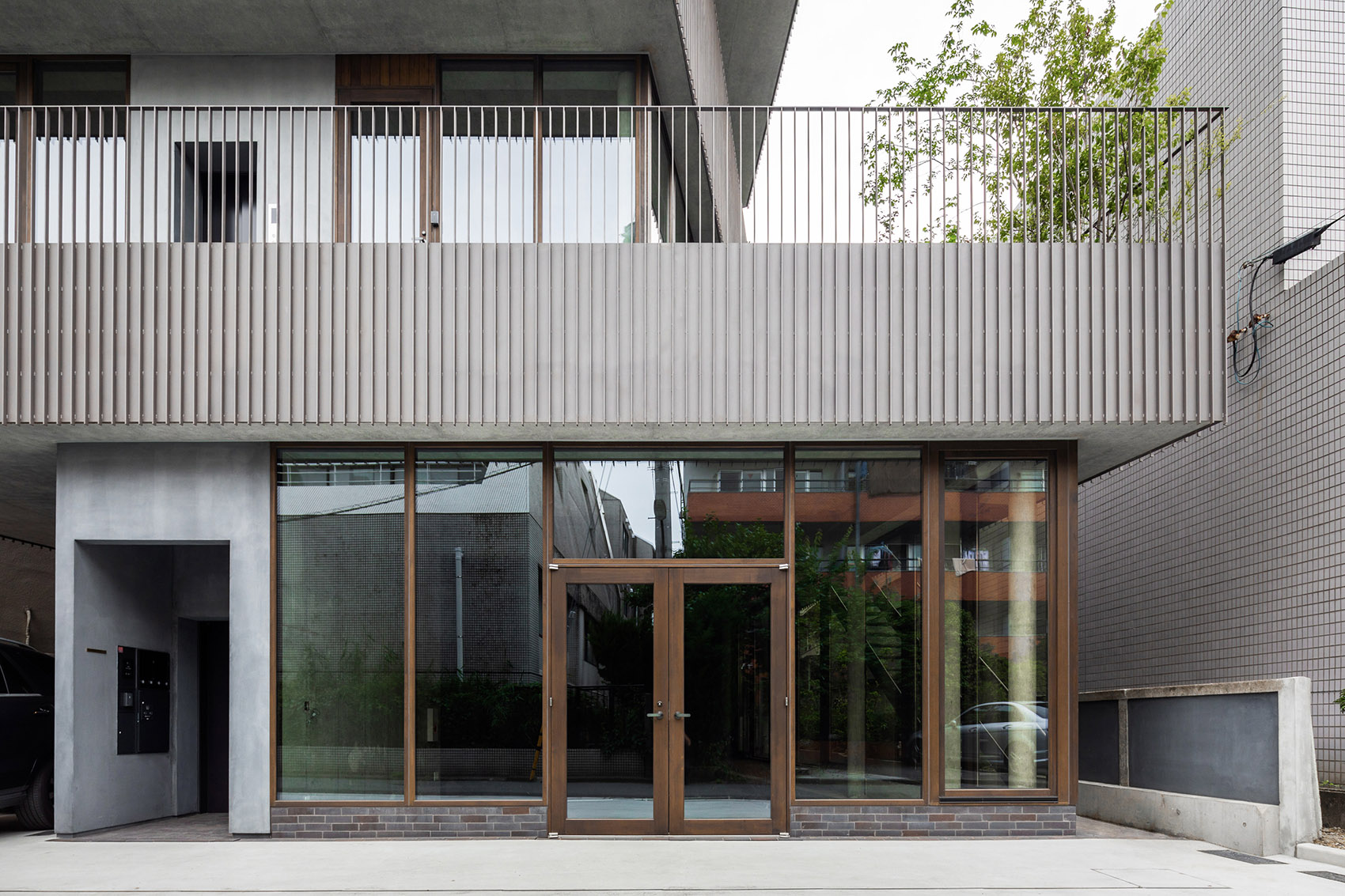
▼竖向百叶状的金属格栅形成了露台的扶手栏杆, the repetitive vertical slats like louvers also serve as handrail © Vincent Hecht
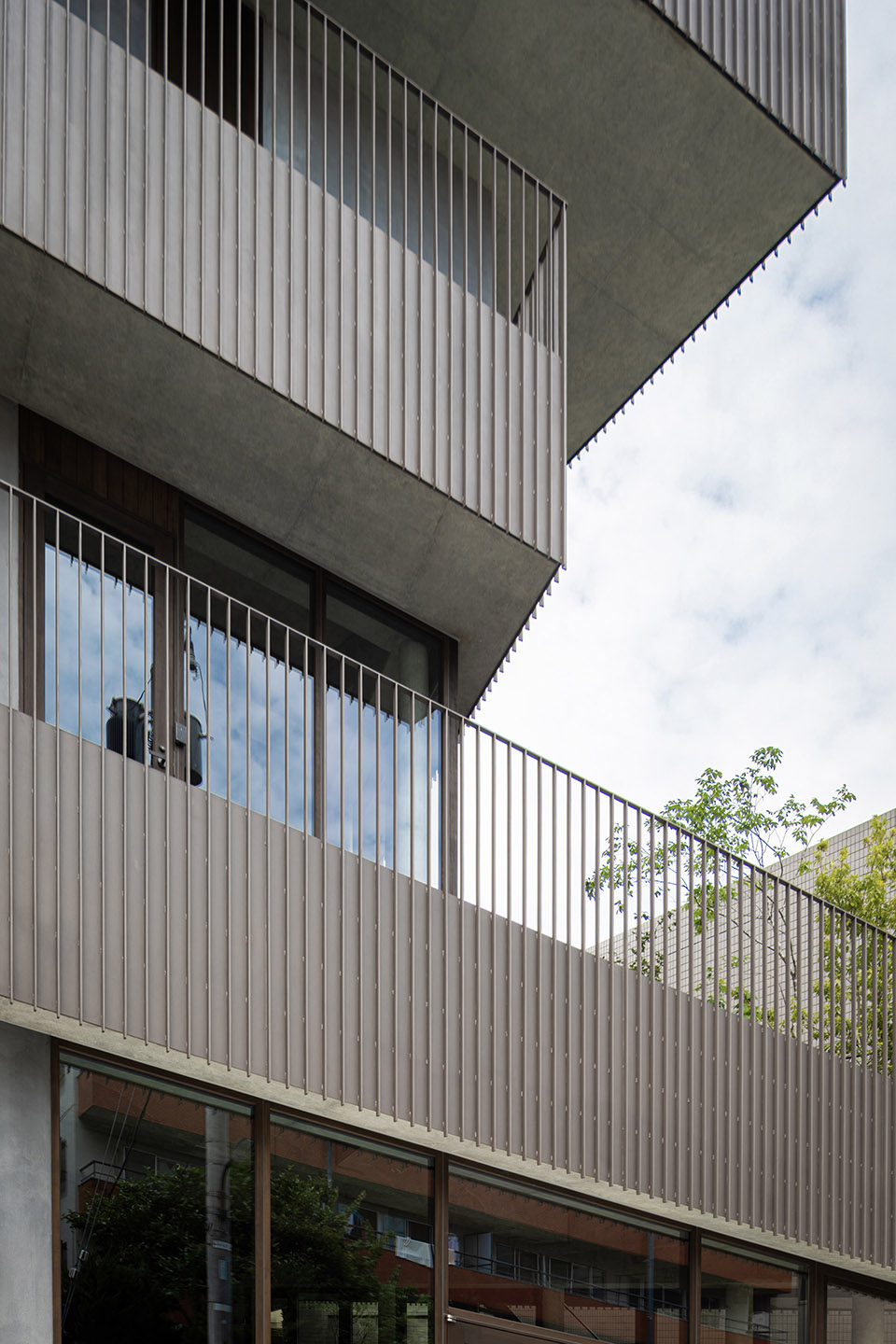
▼立面细部,detail of the facade © Vincent Hecht
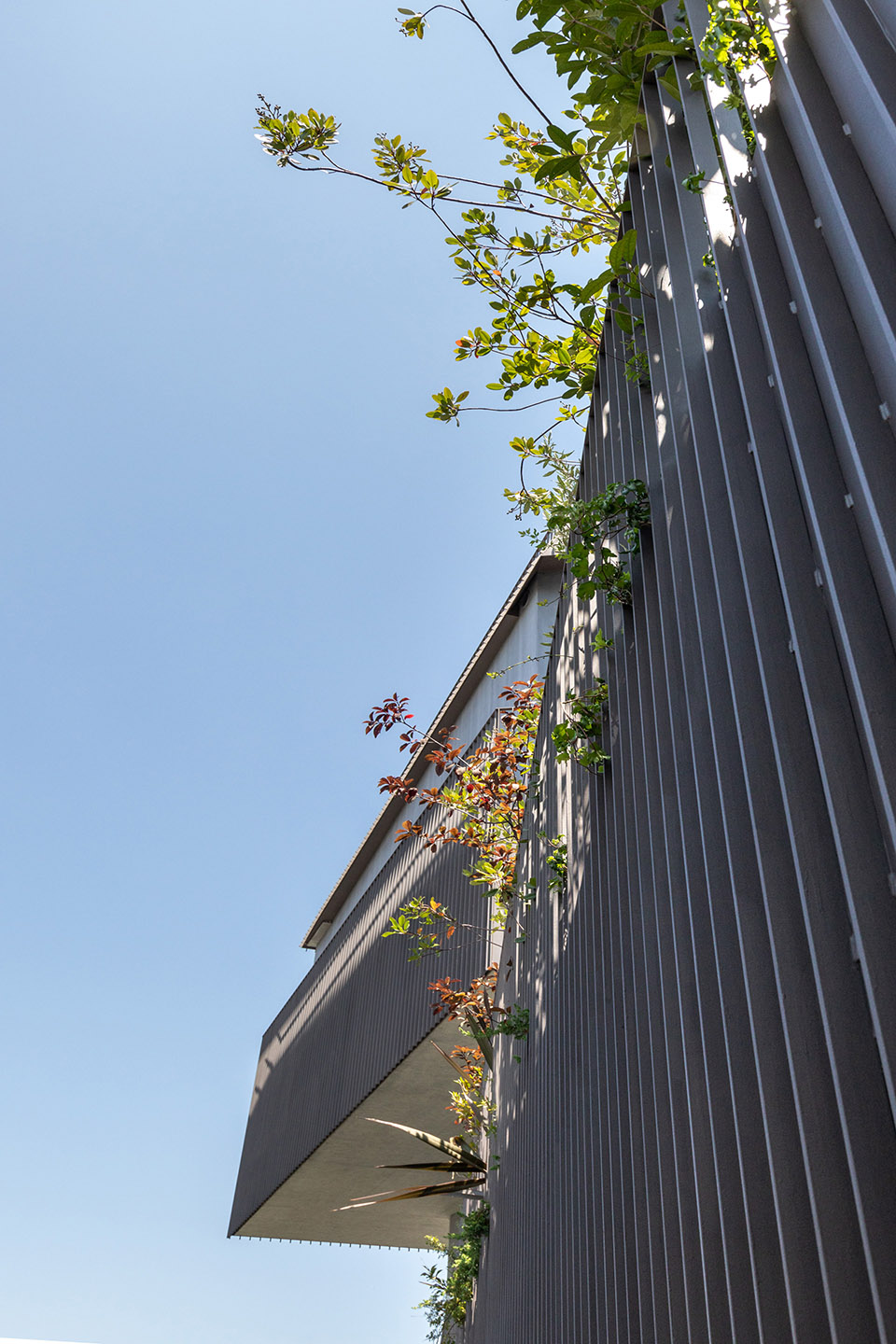
在最近颁布的规范中,大型木框架玻璃幕墙通过了防火认证,因此可以运用在本项目中,这些玻璃幕墙创造出开放明亮的室内空间,打破了包括本场地在内的大多数人口密集的城市地区所要求的典型防火建筑的刻板印象。建筑周围的空地与住宅的每个露台上都布满了茂盛的植被,形成了层叠有序的垂直花园,宛如一座从底层庭院延伸到天空的绿色山谷。
Large timber window walls recently certificated for fire resistance deliver open and bright interior spaces, unlike typical fireproof buildings required in most of the dense urban areas including this site. The void space around the building with distributed lush vegetations at each terrace forms a cascade of sequential vertical gardens like a canyon stretching from the bottom courtyard towards the sky.
▼木制框架玻璃幕,Large timber window walls © Vincent Hecht
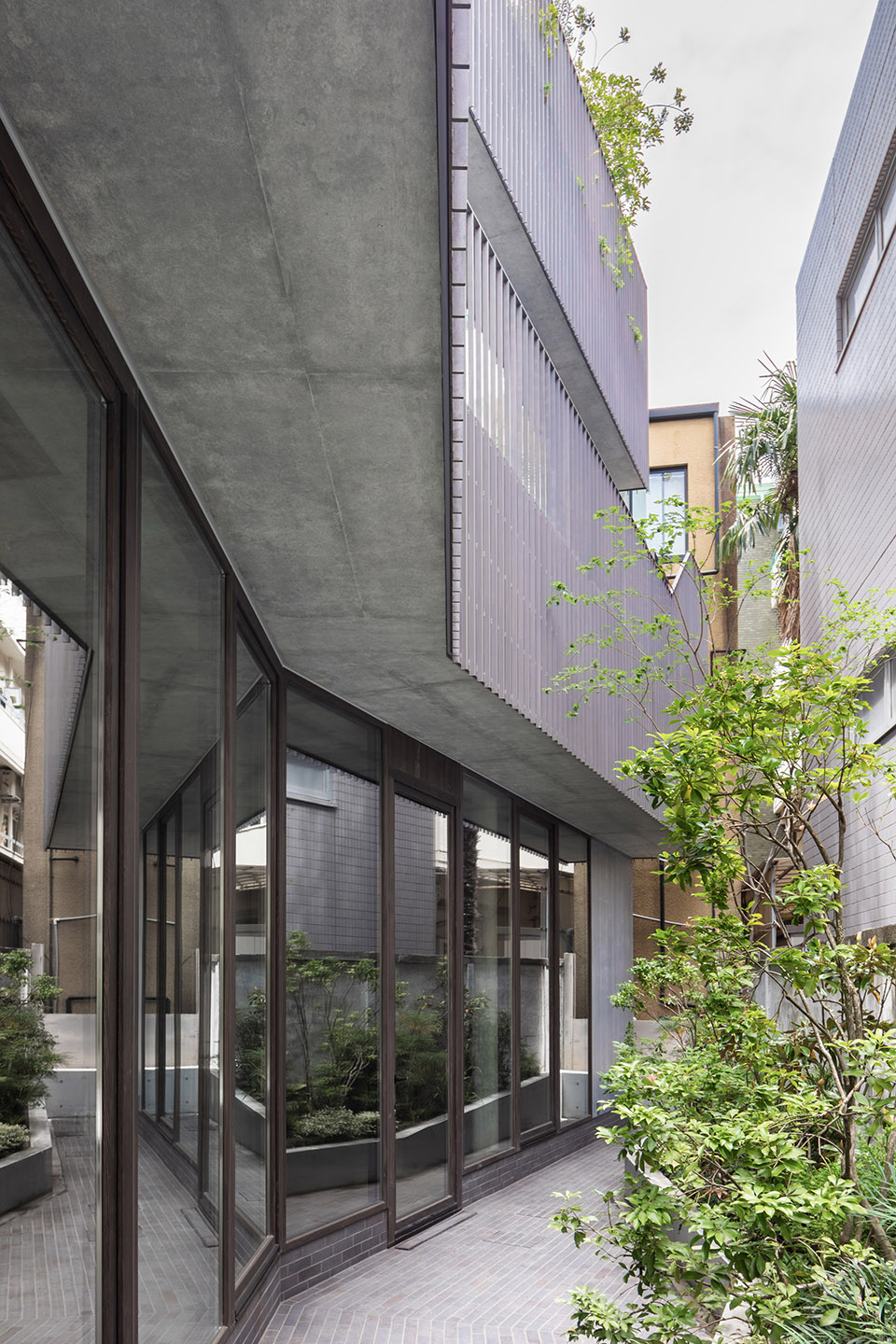
▼室外楼梯与露台,outdoor staircase and terraces © Vincent Hecht

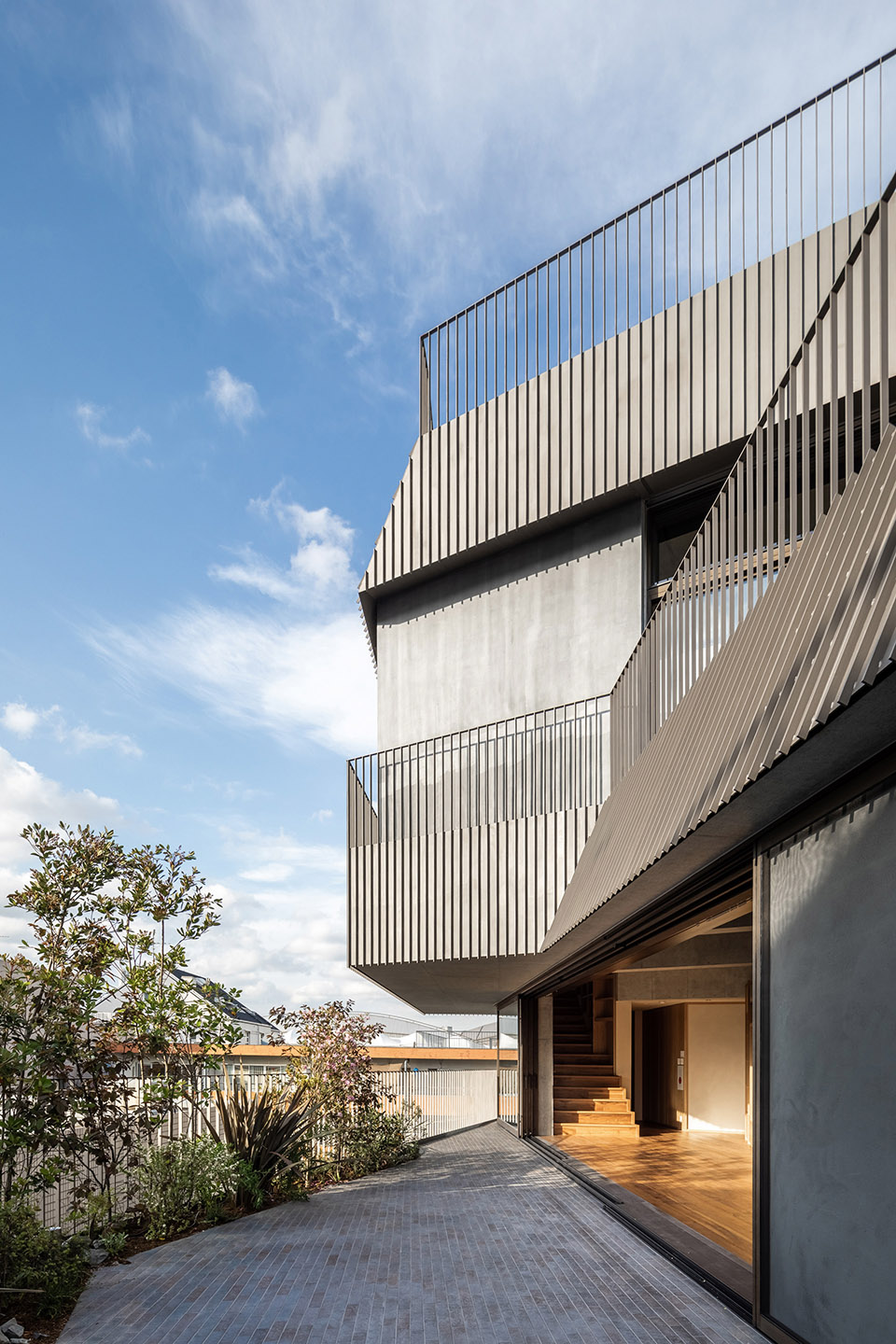
▼由露台看周围密集的城市环境,viewing the intense urban environment from the terrace © Vincent Hecht
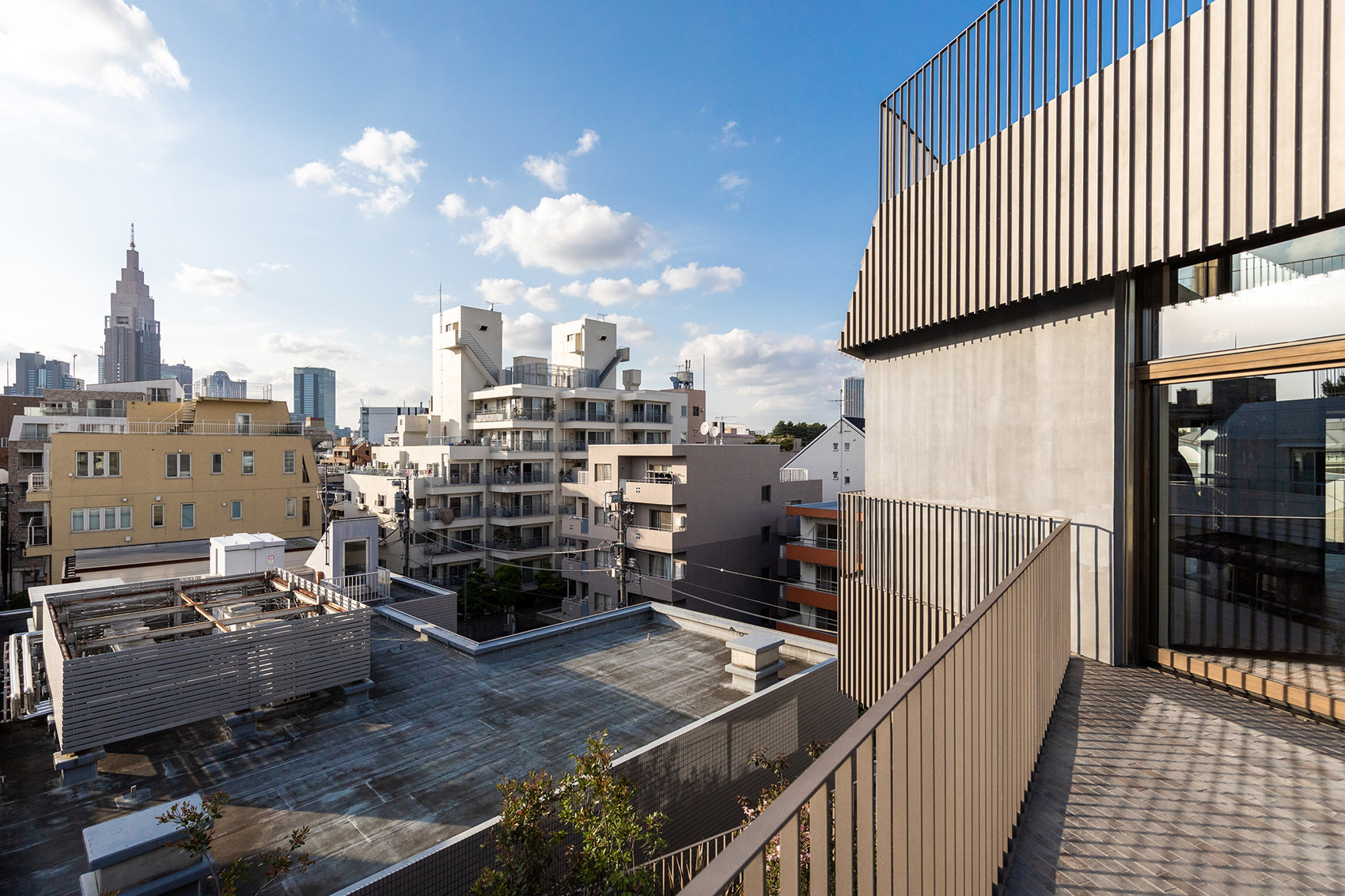
通过采用深梁结构,每层地板下形成了约半层厚的基础层,为上下两个楼层提供了容纳基础设施的空间,如设备间、阁楼储藏室、阁楼、地下储藏室、花池等,这种设置使主要空间更加灵活开放。
The resulting structural depth about half a storey deep functions as servant layers between each floor, providing infrastructural supports to the floor below and above such as mechanical space, attic storage, loft, underfloor storage, planting pit, etc., which allows the main spaces to be more open and flexible.
▼底部两层出租空间室内概览,overall of the interior of the rentable floors © Vincent Hecht
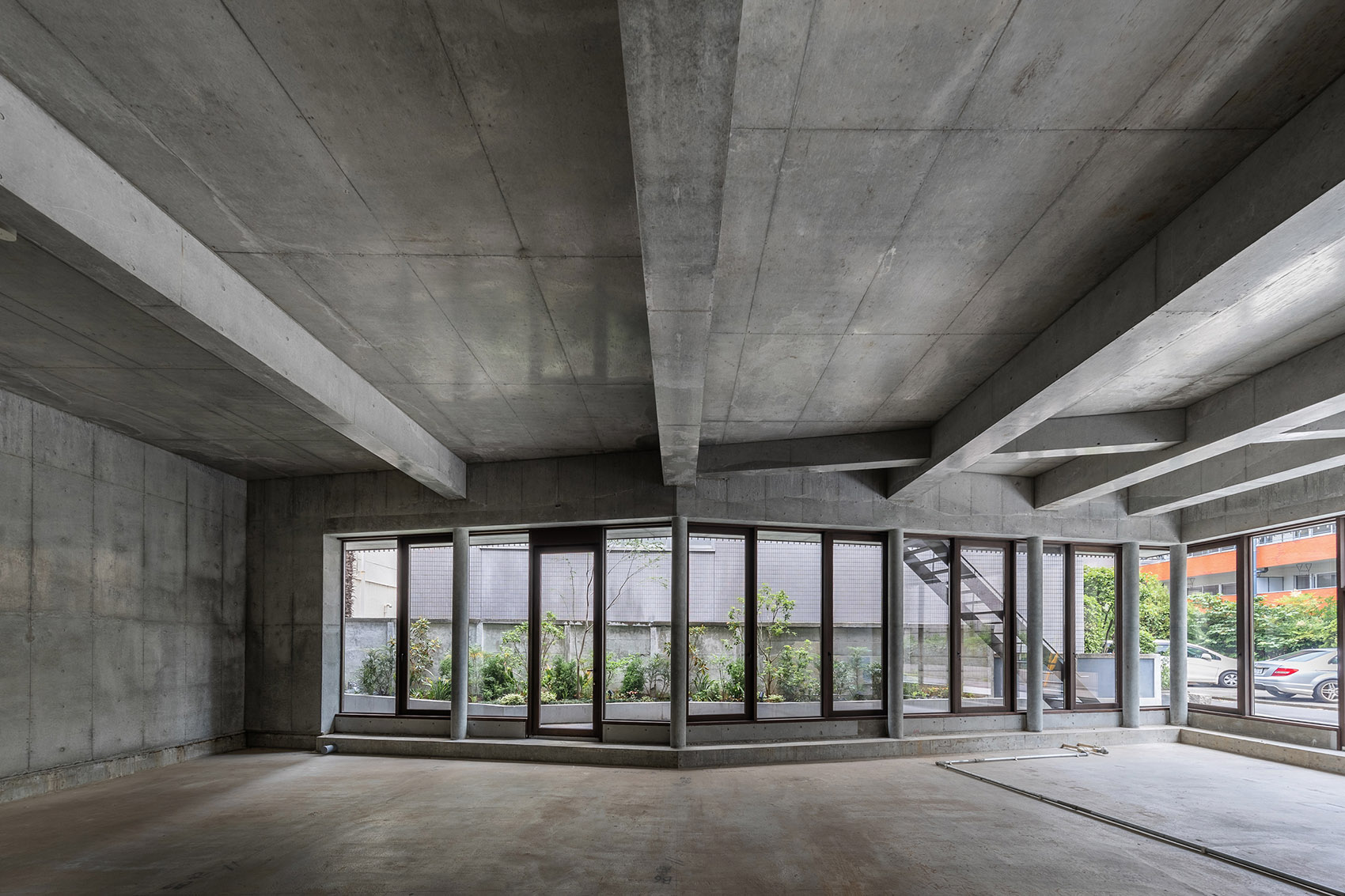
▼深梁结形成了约半层厚的基础设施层,The deep beams form an infrastructure layer about half a layer thick © Vincent Hecht
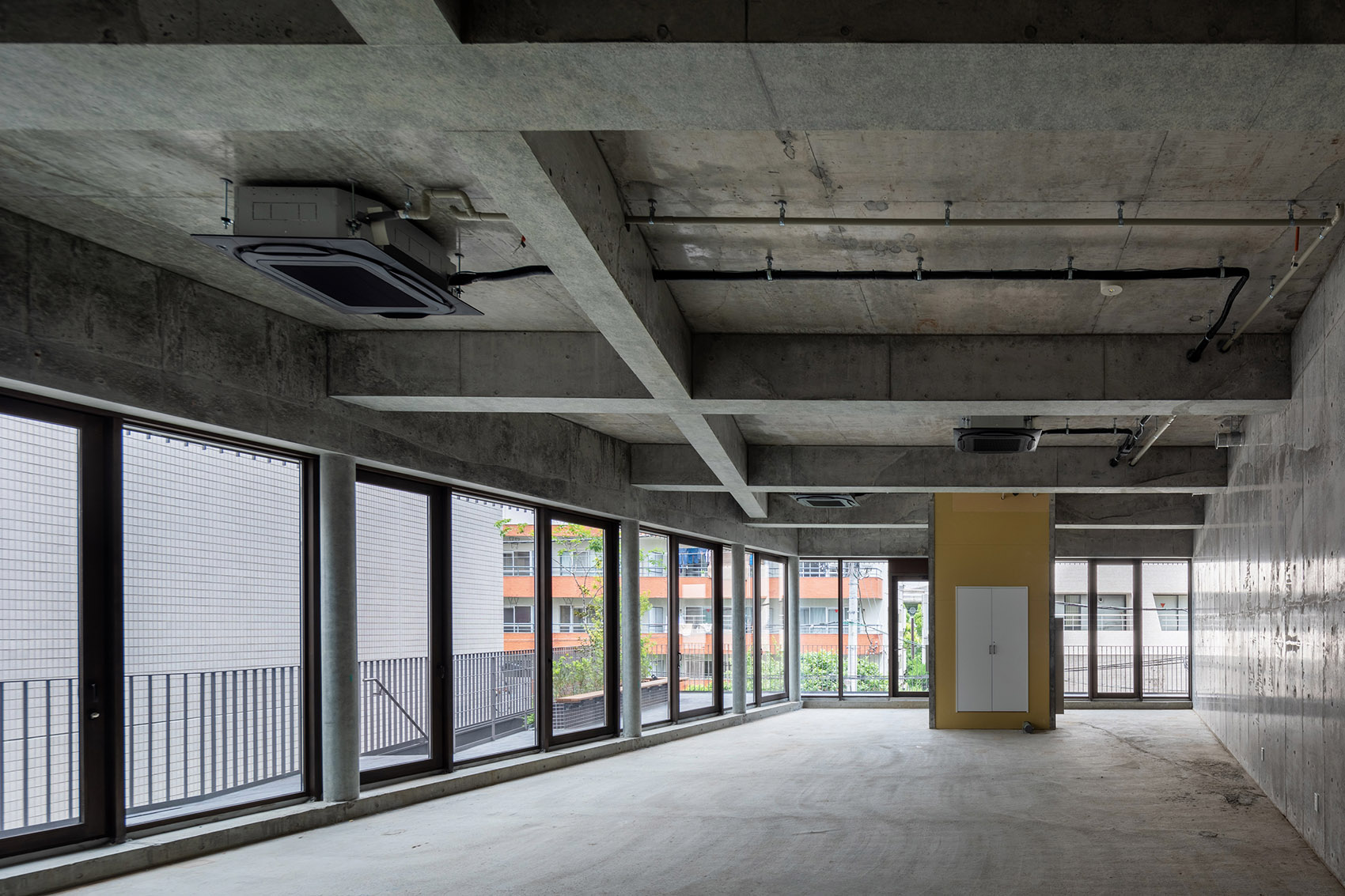
建筑的三层与四层为业主的私人复式住宅,住宅的入口位于最顶层。整个顶层为一个宽敞通透的开放式空间,包含了客厅、厨房等公共生活区域,墙体上部设有高窗。在较低的楼层中,四间卧室与浴室紧凑地排布在一起,房间的外侧为一排带有休憩与储藏功能的书架墙,由于独特的楼板形态与房间布局,这一层的交通空间没有呈现出传统走廊的形式,而是一个三角形的大厅空间。当滑动窗完全打开时,顶层的客厅与三层的大厅空间都可以延伸到宽敞的种植露台上,将室外露台转化成生活空间的一部分。宽敞的楼梯与书房角将客厅和大厅连接在一起,创造出一个连续的空间带,两层的室外露台也由一部布满绿植的室外楼梯连接。
▼位于建筑顶层的私人住宅主要生活区,The main living area of the private residence is located on the top floor of the building © Vincent Hecht
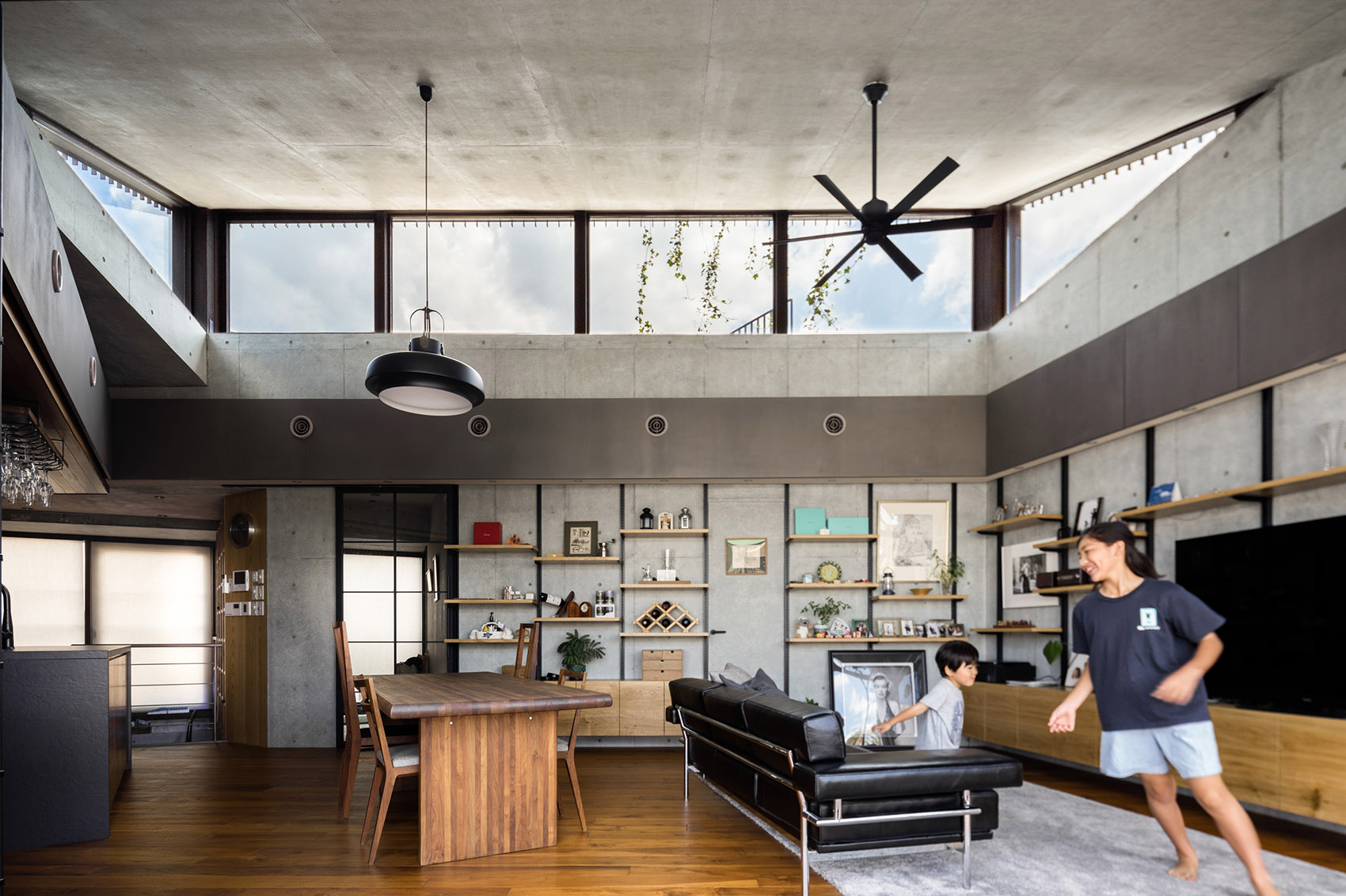
▼当滑动窗完全打开时,顶层的客厅延伸到宽敞的种植露台上,When the sliding Windows are fully open, the living room on the top floor extends onto a spacious planted terrace © Vincent Hecht

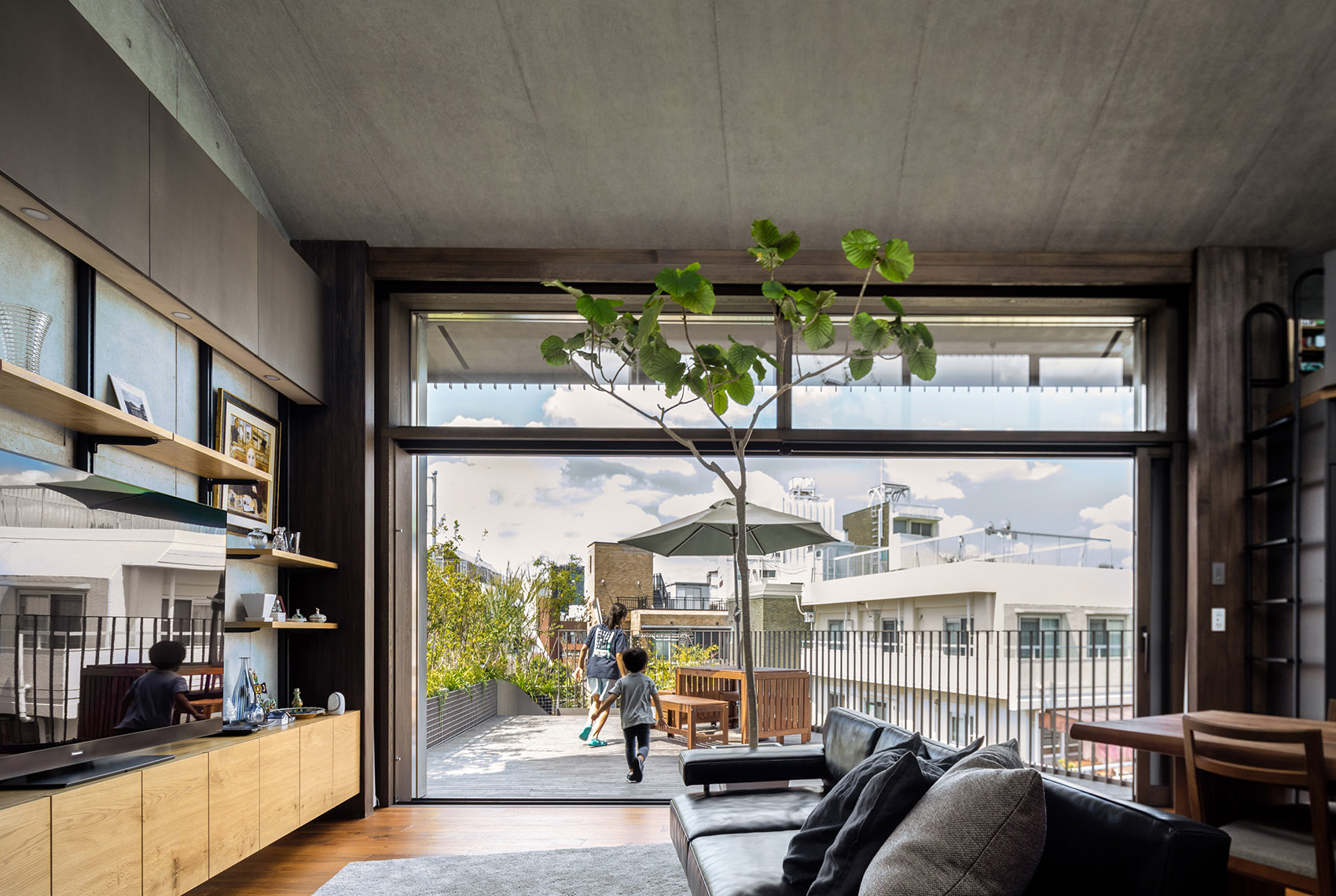
▼模糊的室内外界限与顶部的高窗,the blurred boundary between interior/ exterior ant the clerestory windows at the top © Vincent Hecht
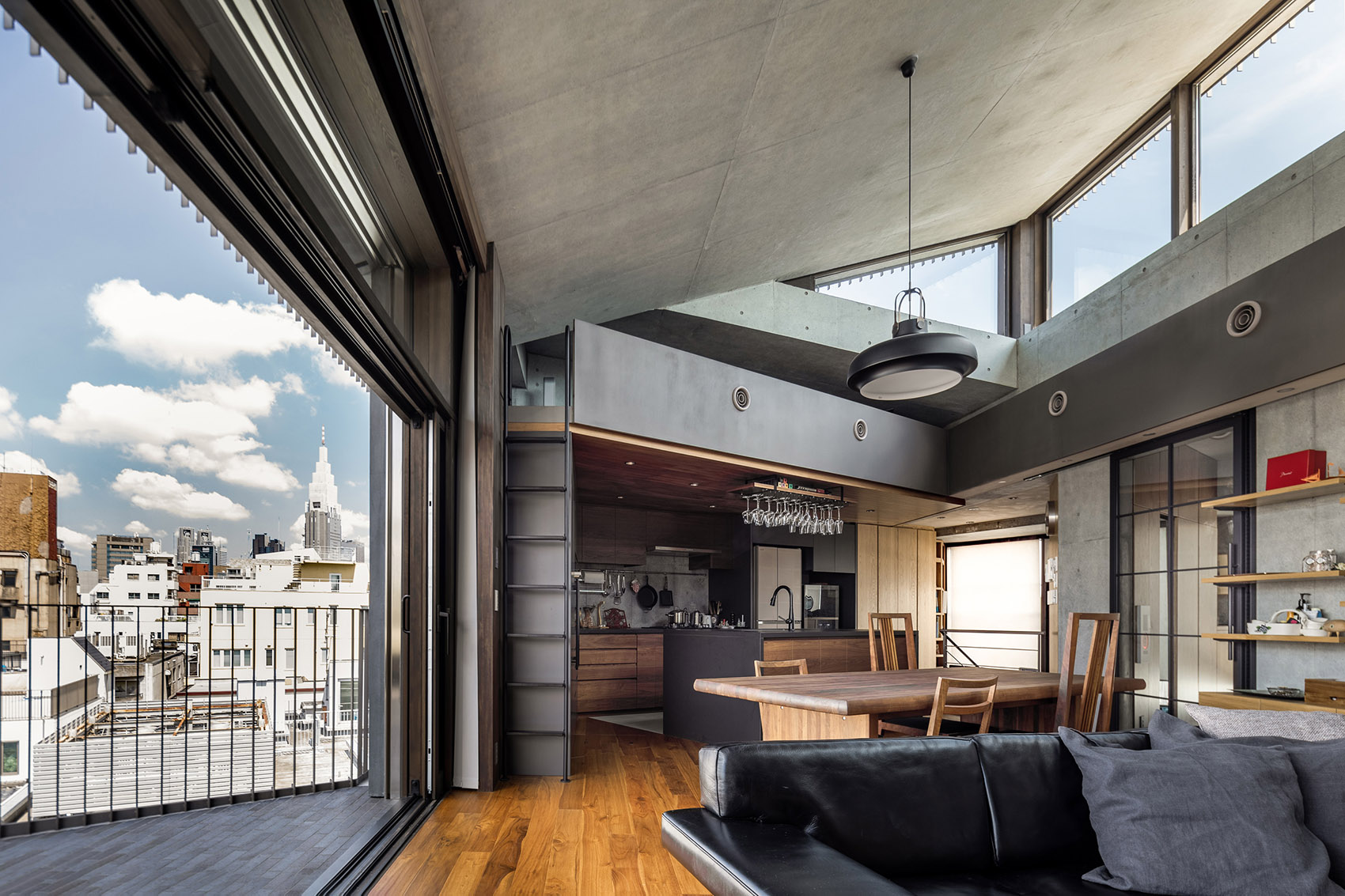
The top floor of the building, the entrance level of the duplex residence accommodates the tall and generous single room with clerestory windows for the living room and kitchen. On the floor below, the triangular hall surrounded by the bookshelves anchor four bedrooms and bathrooms. Through the fully openable sliding windows at each floor, both the living room and the hall are enabled to extend towards the generous planted terraces to become a part of living spaces. While the generous stairway with the study corner connects the living room and the hall openly to create a continuous spatial strip, two terraces are also connected through the outdoor stairway surrounded by abundant vegetation.
▼位于三层的三角形大厅与多功能书架墙,the triangular hall surrounded by the bookshelves © Vincent Hecht
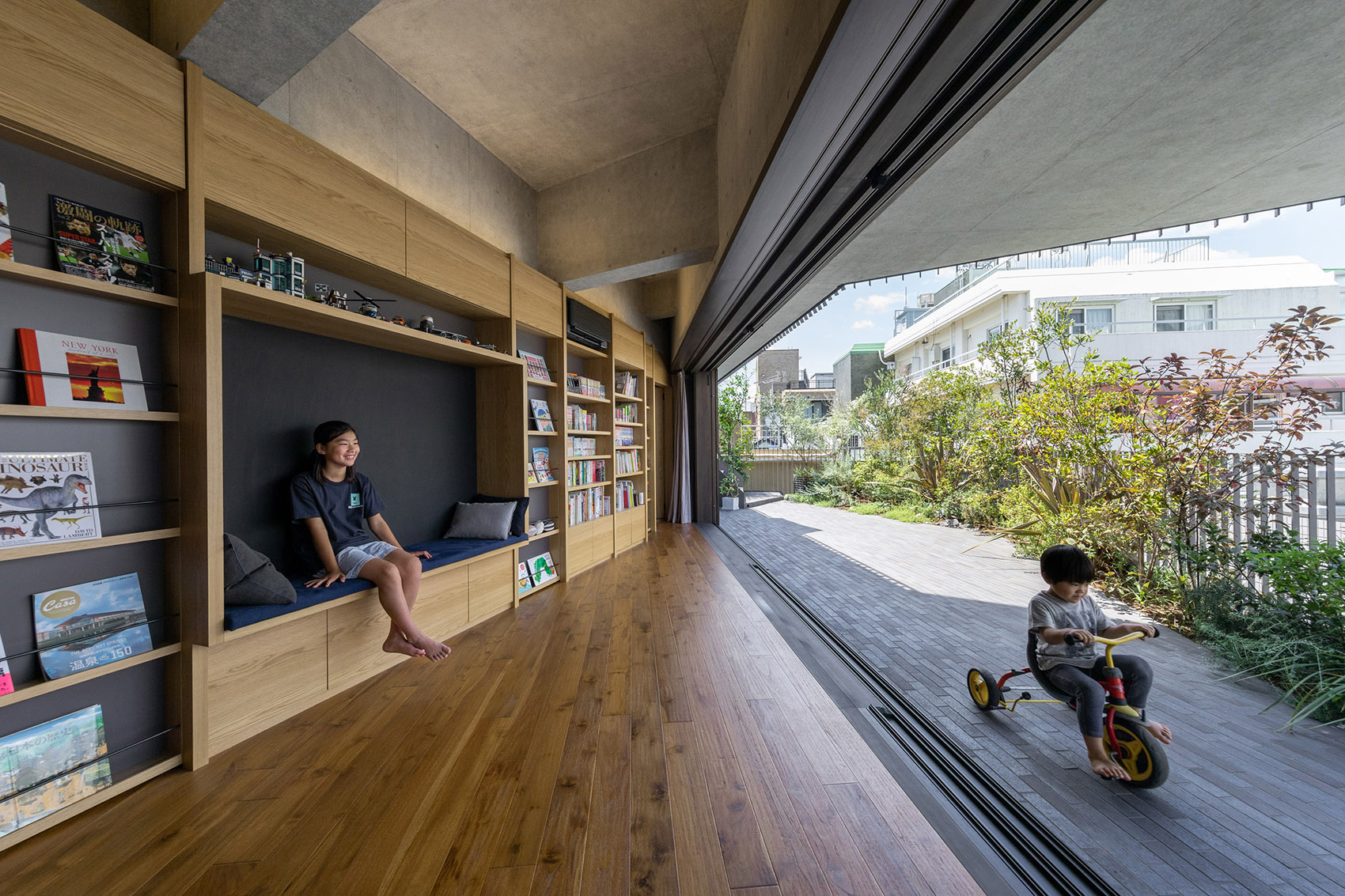
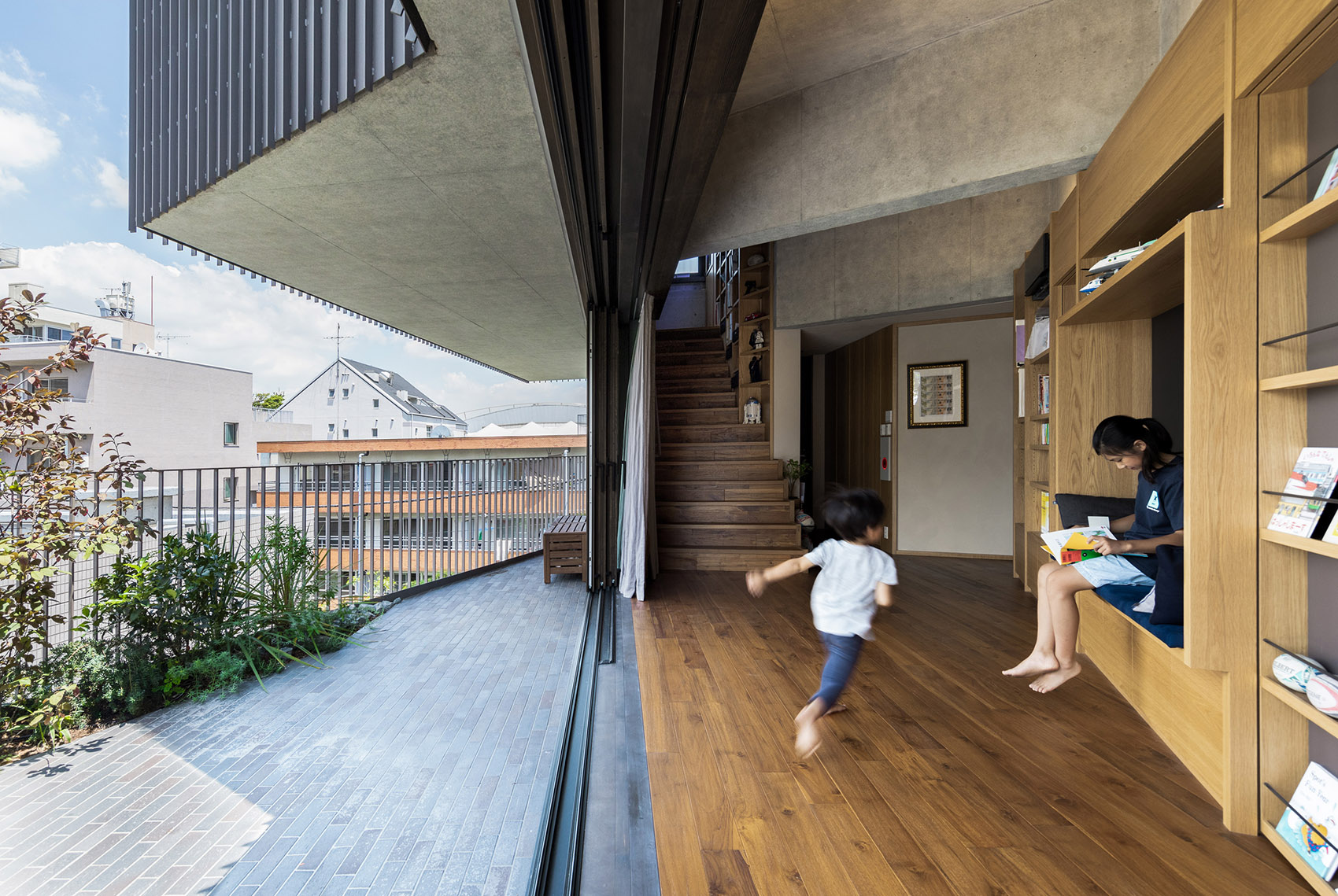
▼楼梯与转角书架,the generous stairway with the study corner © Vincent Hecht
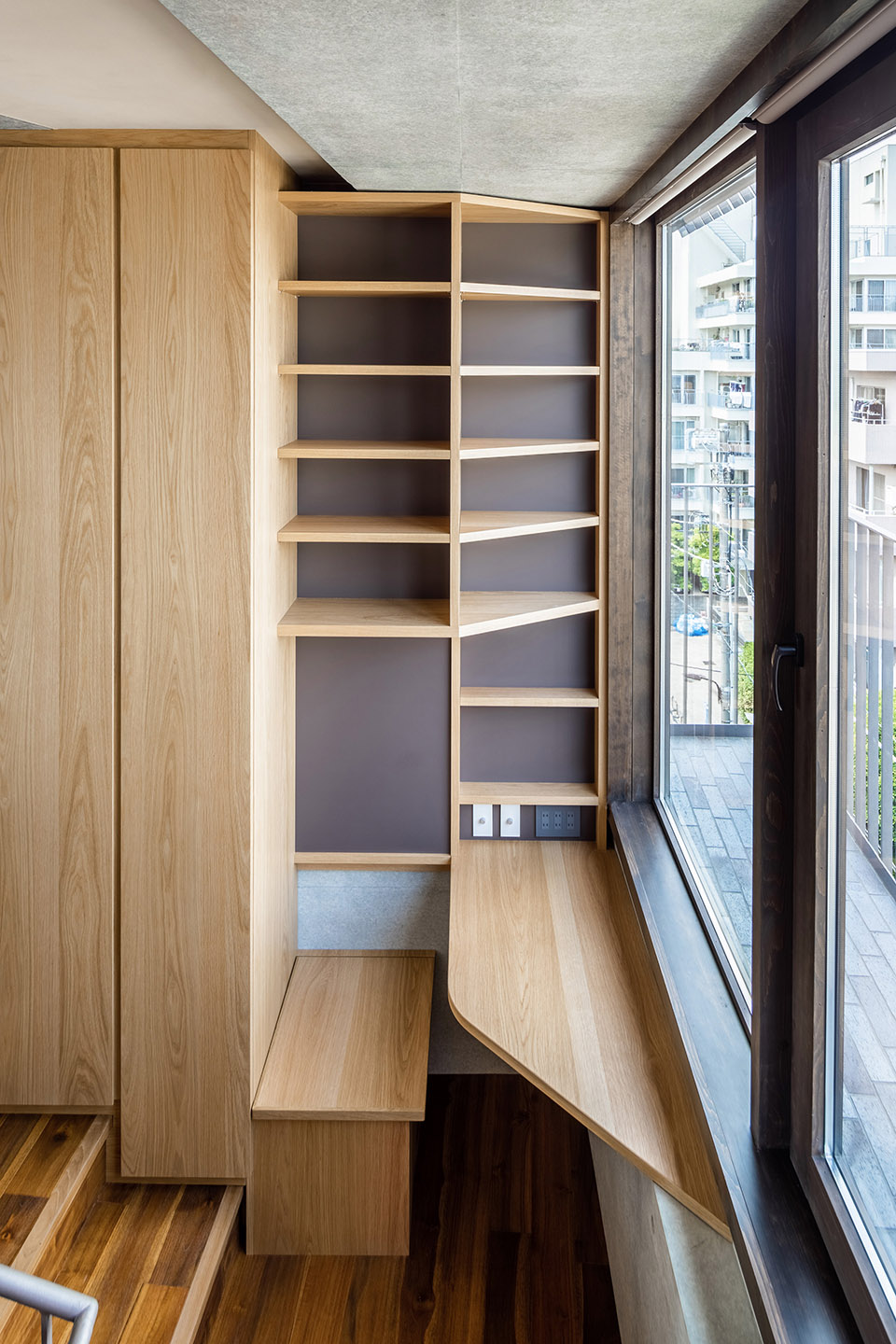
▼三角形大厅窄侧的开窗,the window at the end of the triangle hall © Vincent Hecht
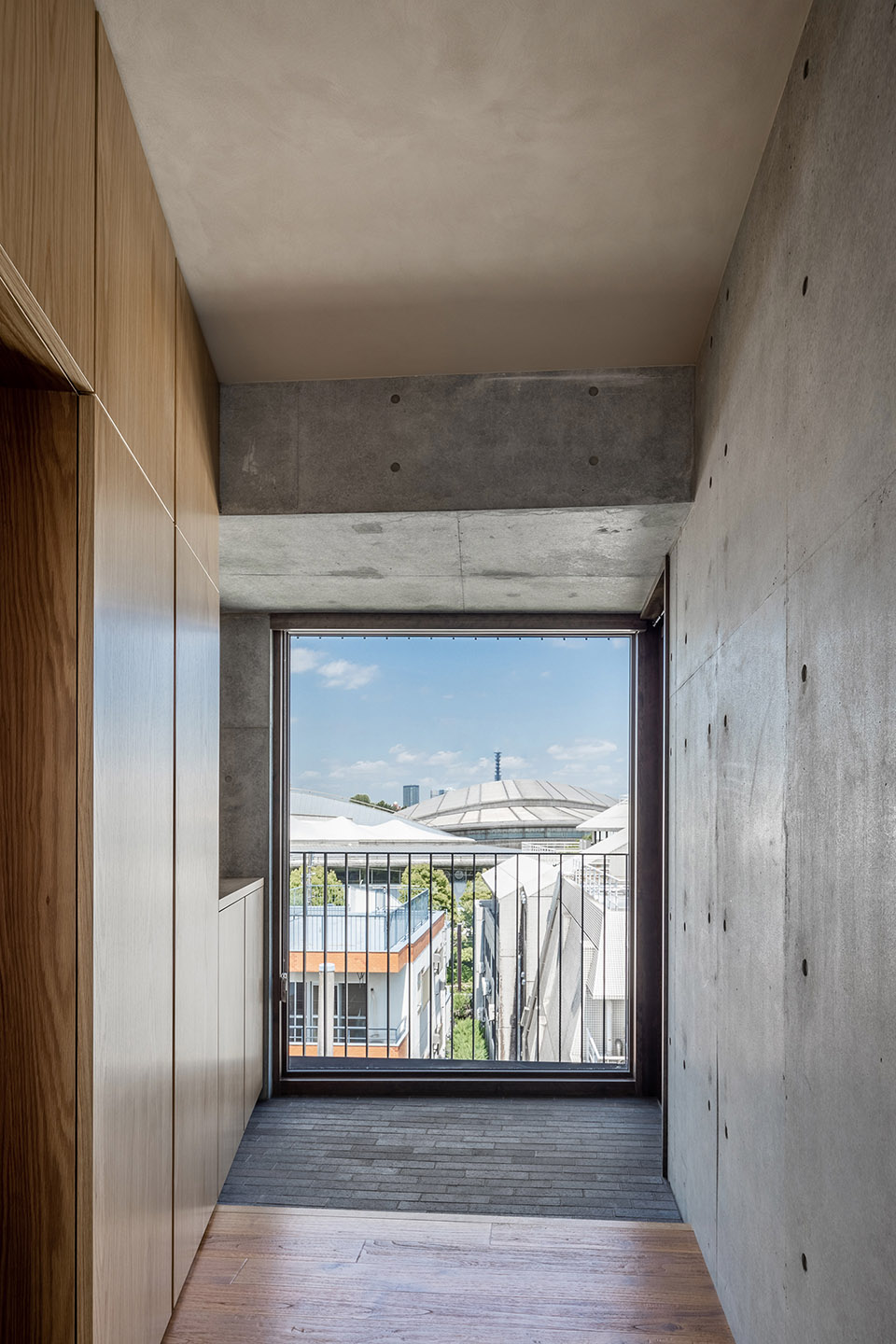
另一处屋顶露台沿着客厅的高窗盘旋上升,连接到人造草皮覆盖的宽阔屋顶斜坡上,这个几乎漂浮在天空中的天台是孩子们的专属游乐场。三个露台将整栋复式住宅的内外空间串联了起来,形成了一种生活空间的“三维循环”。各种各样的家具与植被分布在这个生活空间环路的外围,为每个角落都营造出不同的氛围与性格。孩子们在这里欢快地跑来跑去,光线、空气、景观以及所有生命和自然元素都在室内外之间流畅地循环。
Beyond the clerestory window of the living room, another roof terrace spirals up to the wide slope covered by the artificial turf, an exclusive playground almost floating over the sky. As a result, a spatial continuum of inside and outside runs throughout the duplex and three levels of the terraces, which forms a sort of a ‘three-dimensional loop’ of the living spaces. Various casework and vegetation are distributed along the periphery of this living space loop, creating different characters of the places. Besides joyful kids running around, light, air, view, and all the flow of life and nature circulate seamlessly throughout inside and outside.
▼三层露台,terrace of the third floor © Vincent Hecht
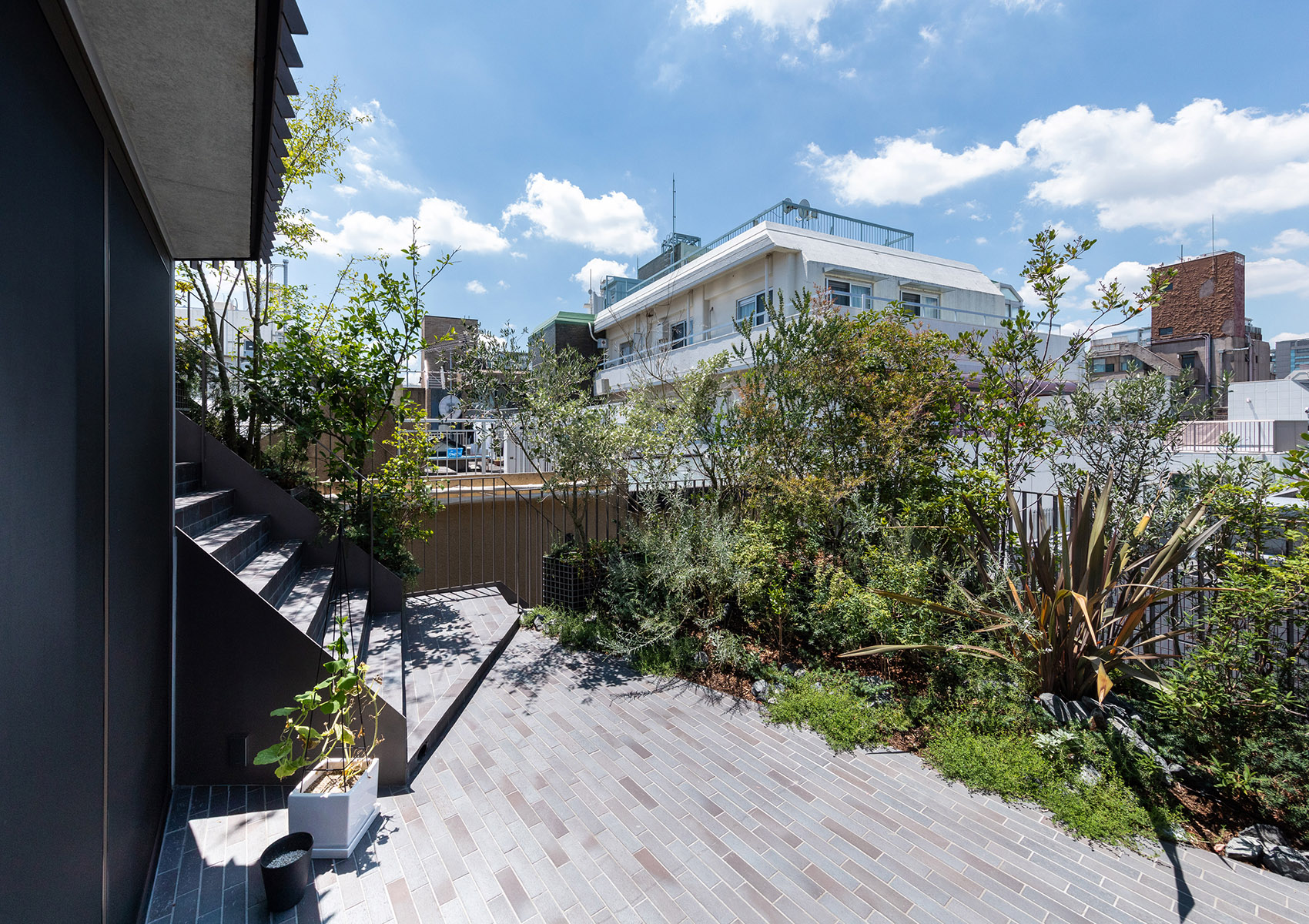
▼连接私人住宅上下两层露台的室外楼梯, the outdoor staircase that connect the terraces of the duplex © Vincent Hecht
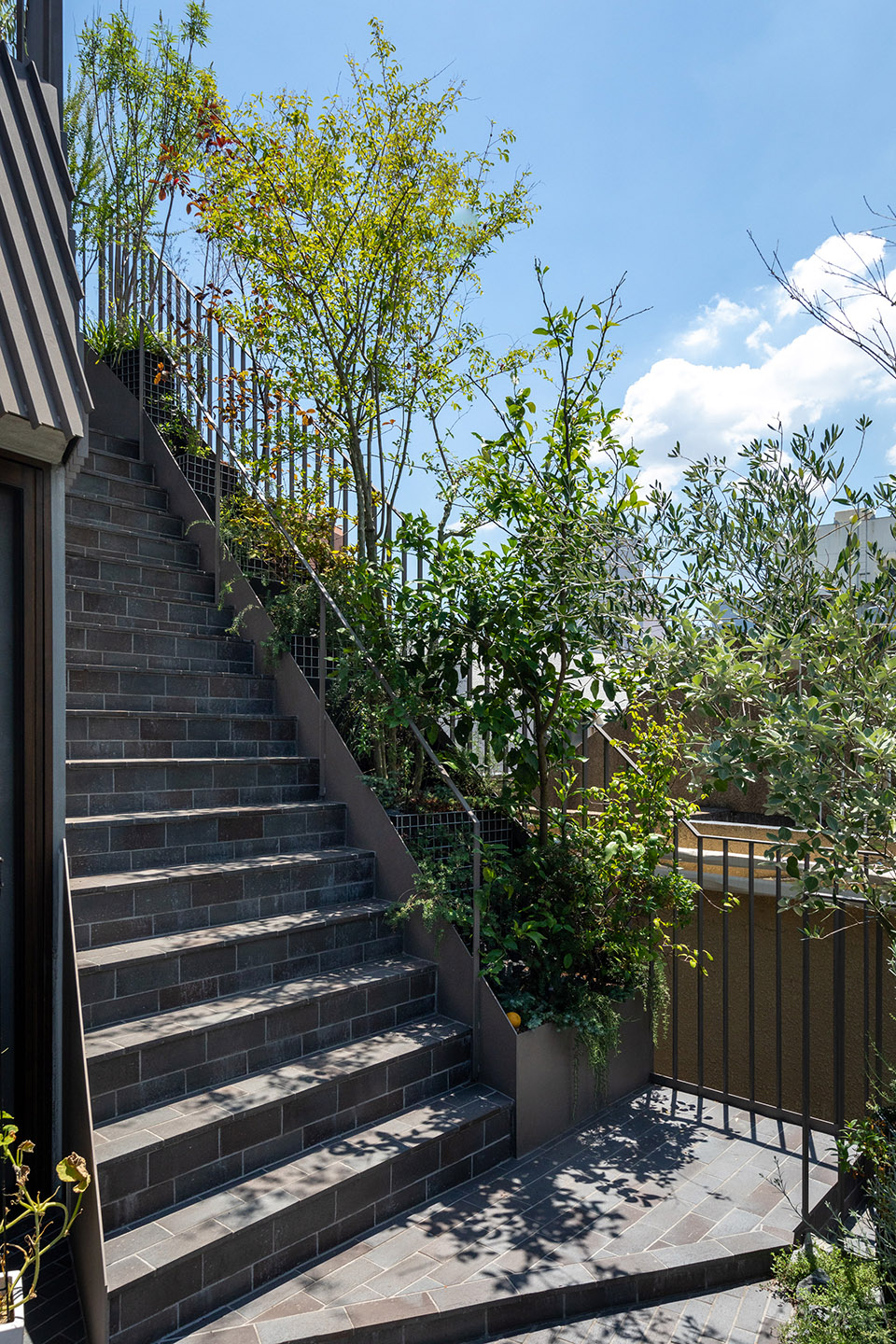
▼顶层露台,terrace of the top floor © Vincent Hecht
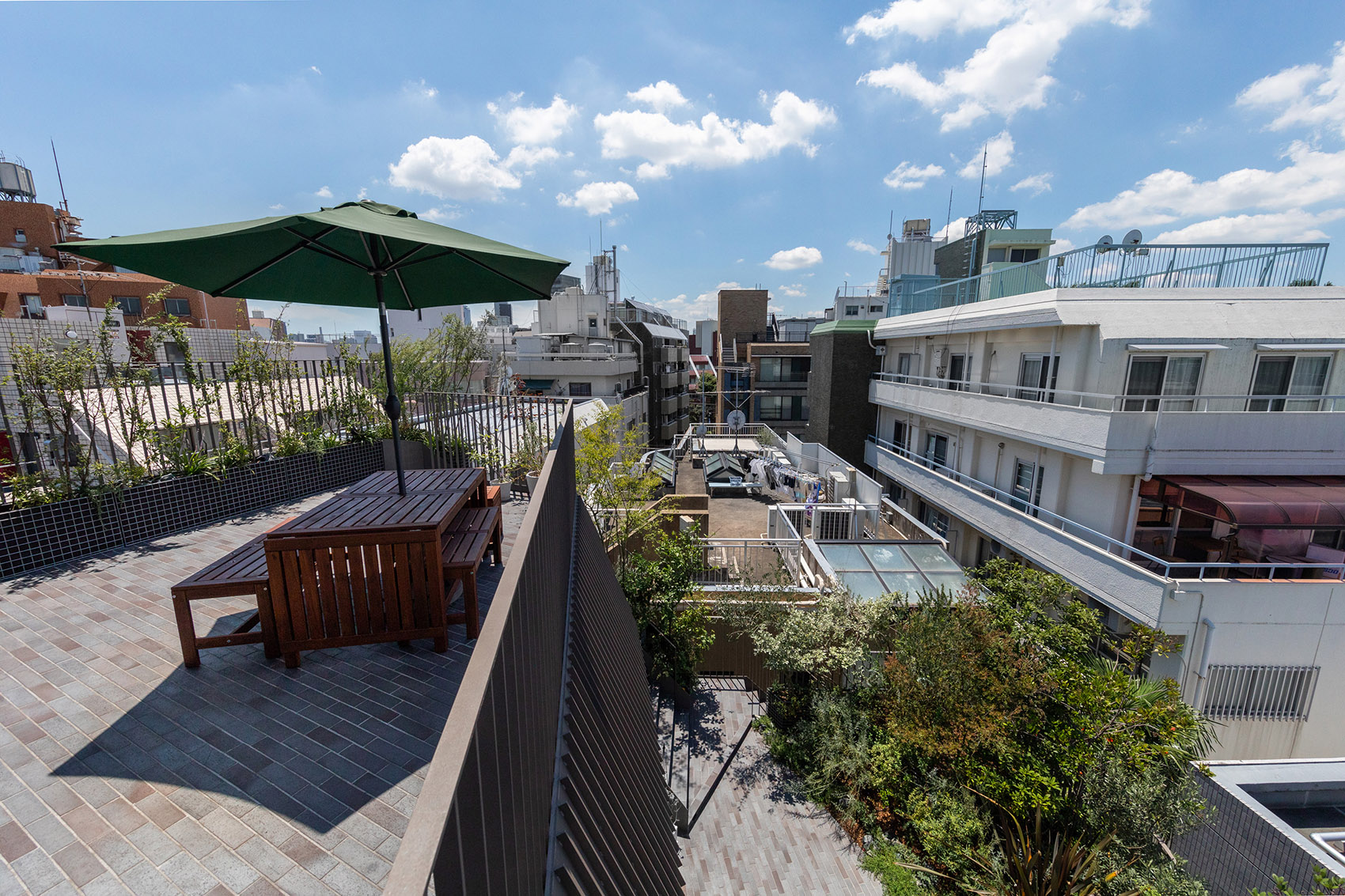
▼带有草坪的屋顶斜坡是孩子们的天空游乐场,The roof slope with lawn is a sky playground for children © Vincent Hecht
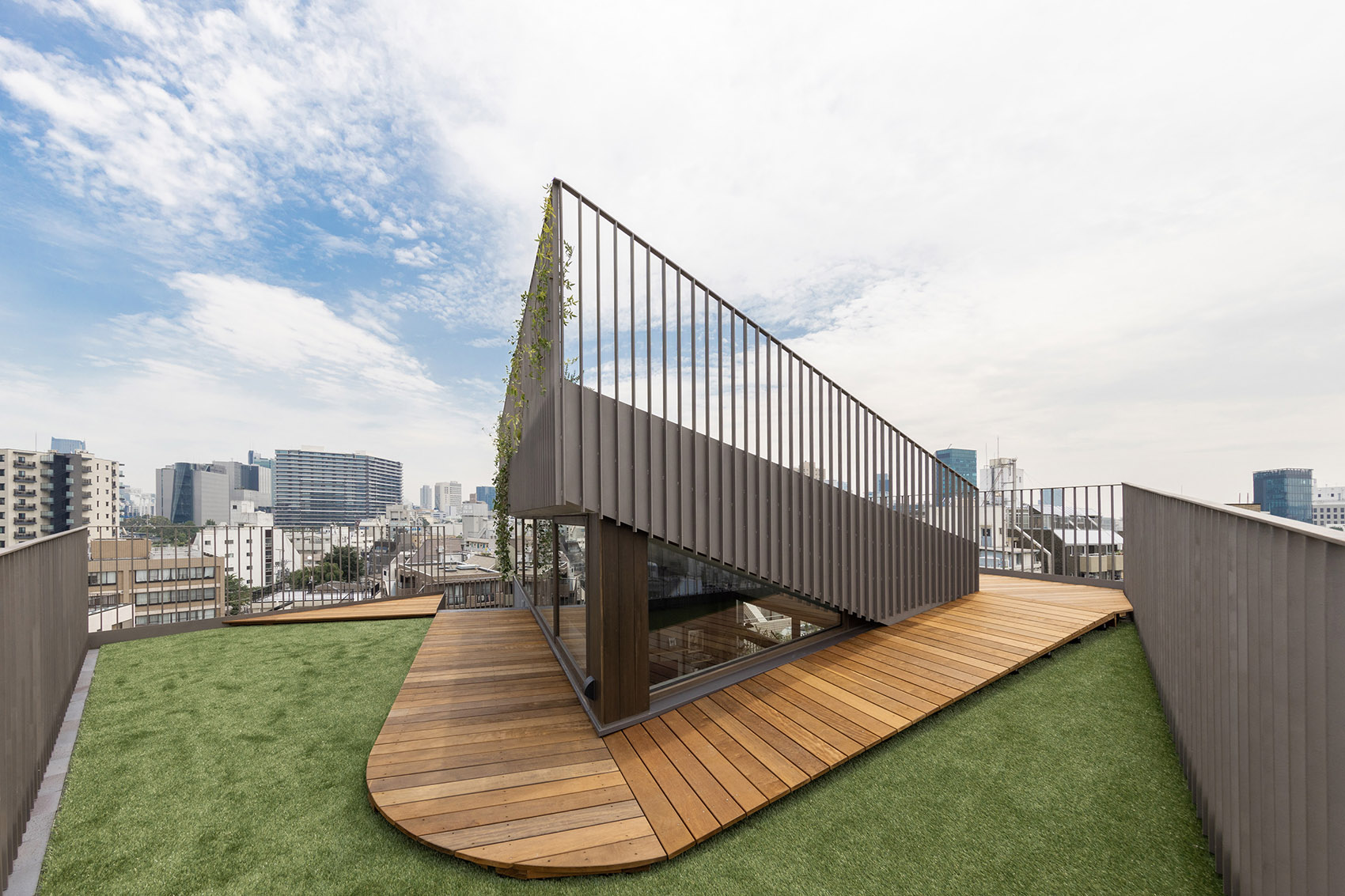

通过对场地条件与局限性的详细分析和研究,KOMPAS事务所的建筑师们充分挖掘出该地块的潜力,并将它们精确地整合与升华成一栋独一无二、因地制宜的居住建筑。住宅的外观就像一座矗立在城市肌理中的堡垒,背后则是郁郁葱葱的绿洲。设计理念旨在:在密集的城市背景下,探寻一种自住与出租混合的空间模式,同时创造出有趣且放松的生活环境,为在这里成长的孩子们留下美好的童年回忆。建筑师们希望业主家庭能够在东京天际线的环绕下,开启并享受他们的新生活。
Through the elaborate analysis and studies of the conditions and the limitations, we believe that the discovered potential of the site was well integrated into the distinctive architectural presence specific to this project. Its appearance looks like a fortress standing up in the urban fabric and hilly oasis with lush nature hidden behind. This project is intended to suggest one way of the approach towards mixed-use development and living spaces in the urban context, at the same time we purely pursued the sort of abundant and enjoyable living spaces where we would almost feel envy the kids growing up there. We hope for the client to enjoy their new life surrounded by the Tokyo skyline.
▼夜景,night view © Vincent Hecht
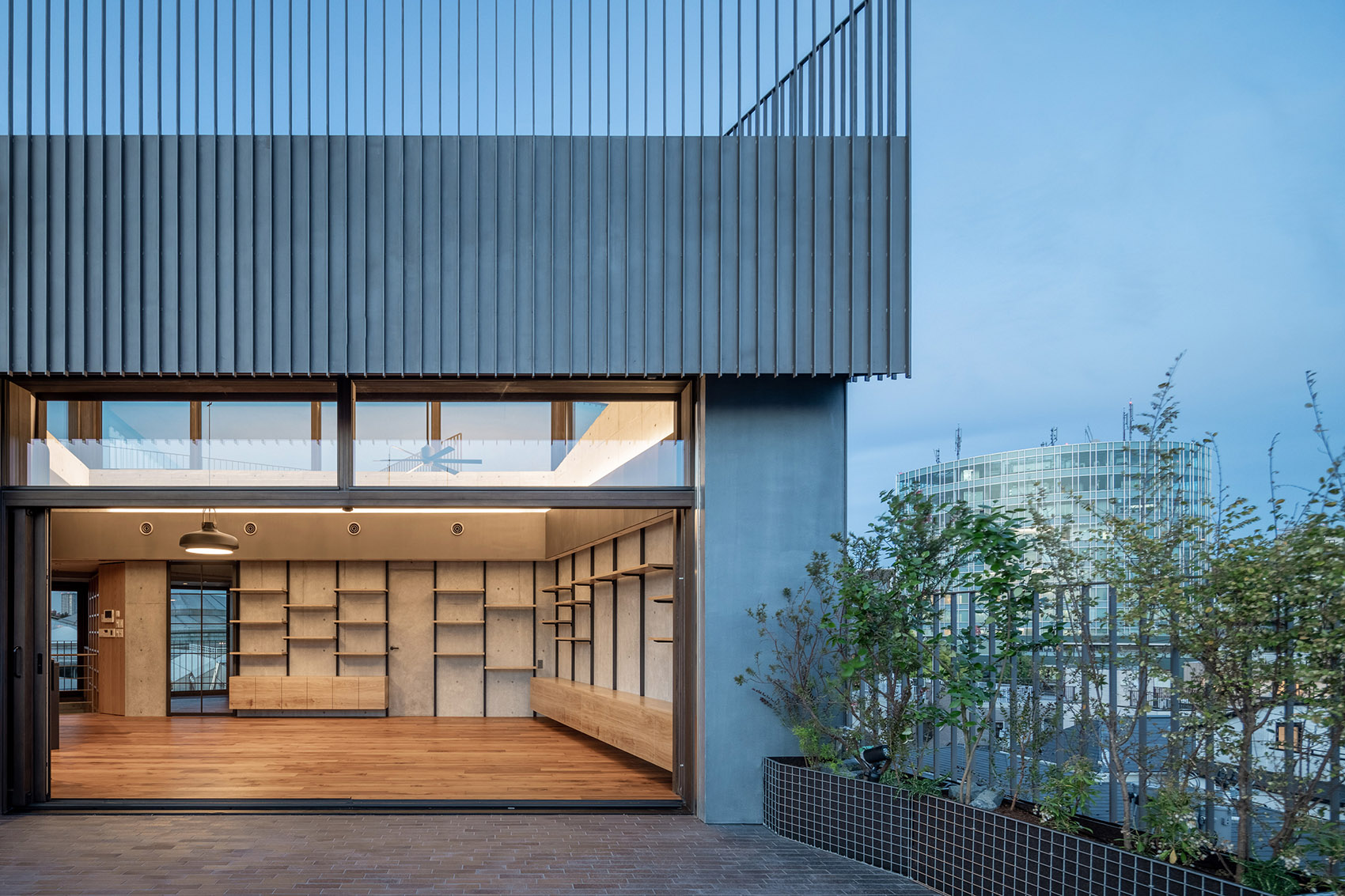
▼总平面图,master plan © KOMPAS
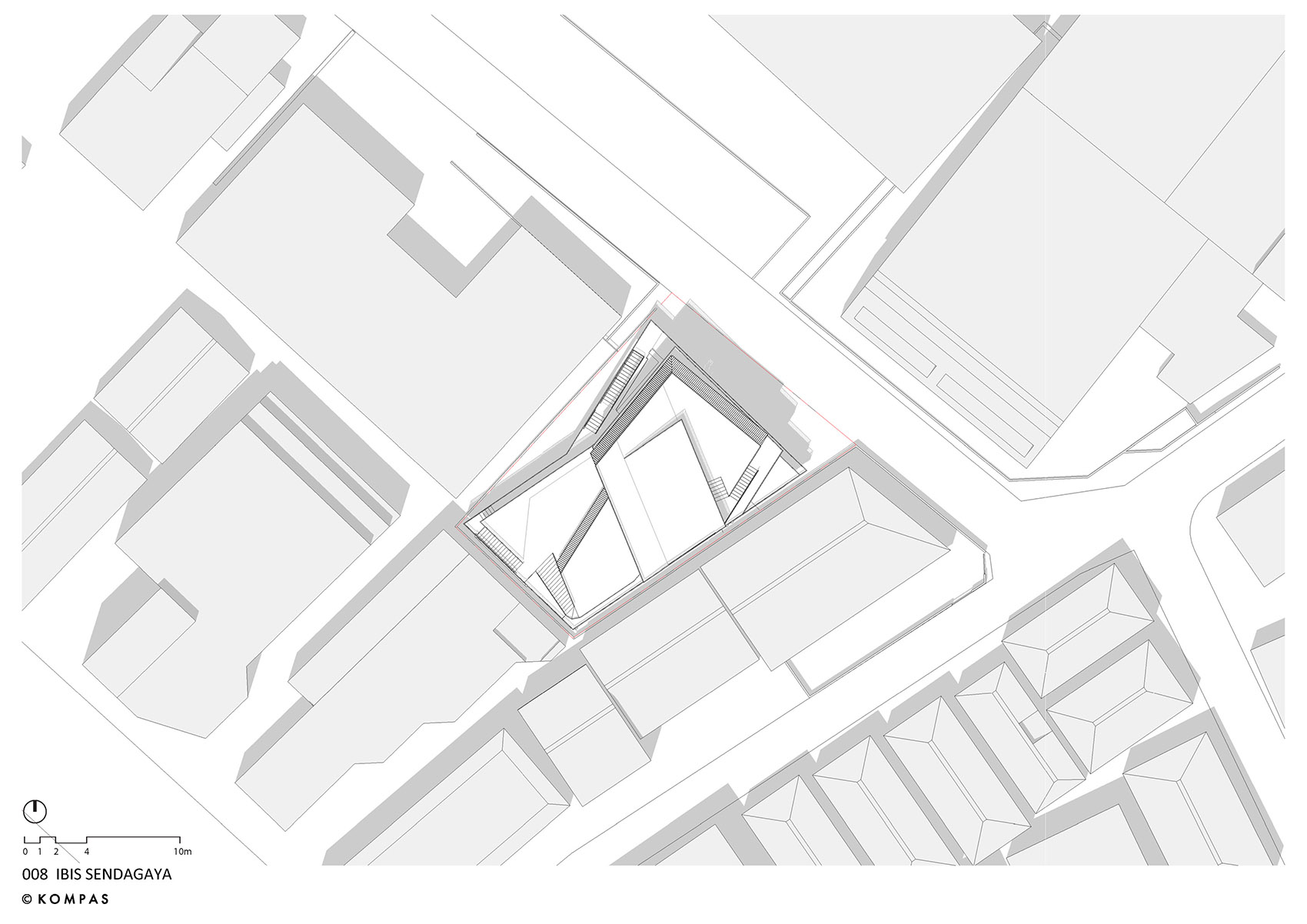
▼剖面图,section © KOMPAS
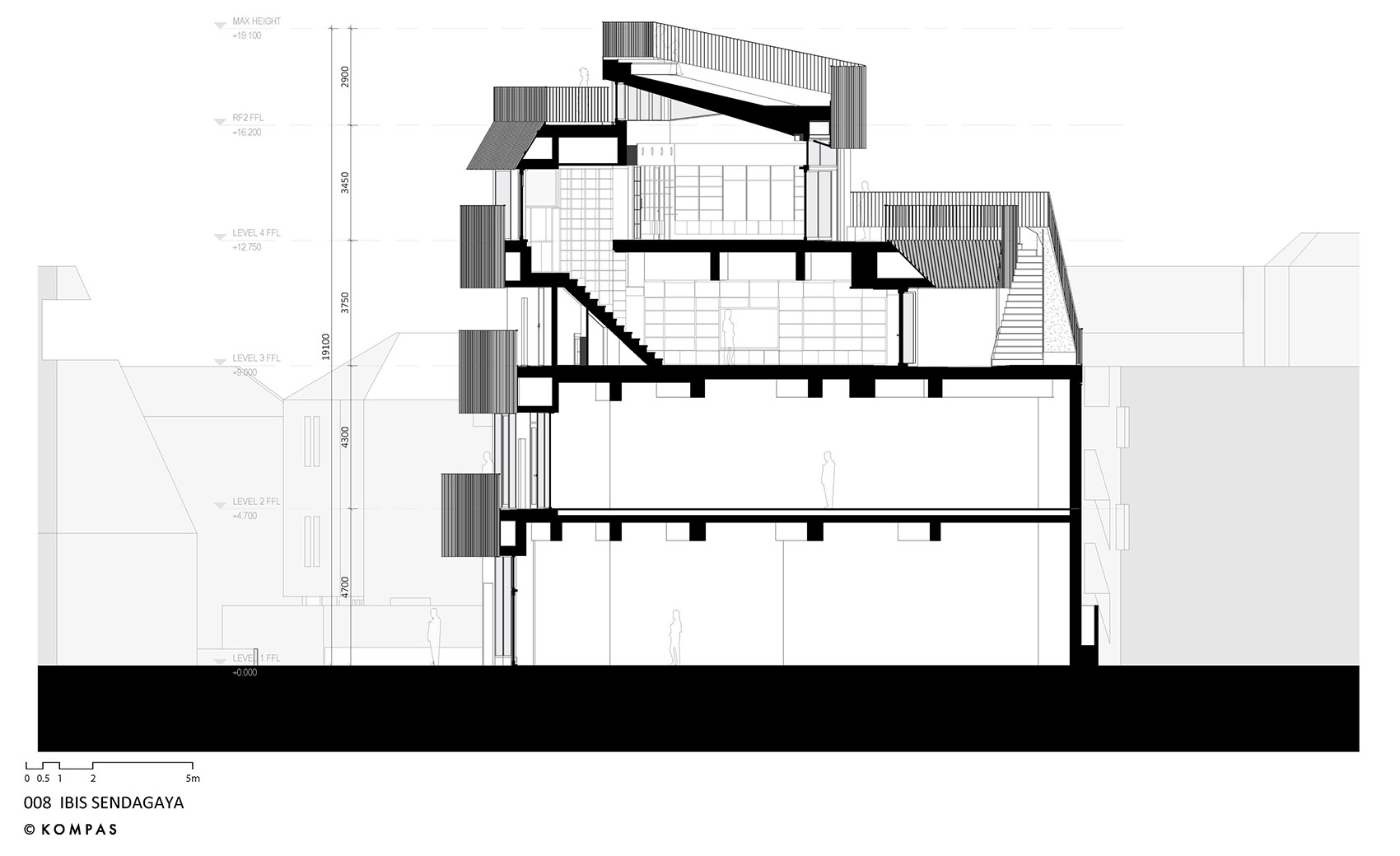
IBIS SENDAGAYA PROJECT : Tenant Space (1&2F) and Client’s Residence (3&4F) STATUS : Completed (2021) LOCATION : Tokyo, Japan SITE : 269 sqm (Max. 160%) BUILDING : Reinforced Concrete Structure, 4 stories AREA : approx. 430 sqm CONTRACTOR : O’hara Architectural and Construction, Ltd. STRUCTURE : HSC MEP : ZO Consulting Engineers LANDSCAPE : Onshitsu / Yuichi Tsukada PHOTOGRAPHY : Vincent Hecht
▼项目更多图片
